Kyiv, Capital of Ukraine — a Beautiful City under Attack
The capital city of Ukraine is Kyiv. It’s also the largest and most populous city in Ukraine. The city’s name is said to come from the name of one of the city’s founders, Kyi.
While you may find references to the city that spell the city name as “Kiev,” this is not the preferred spelling. In the Ukrainian language, the city is spelled Київ, of which “Kyiv” is the proper English transliteration. “Kiev” is a transliteration of the Russian word for the city, Киев. The distinction is important, especially to many Ukrainians, because of the relationship between the two countries and the identity of Ukraine as an independent nation.
Kyiv may not be the best-known European capital, but it is a city with a rich history, impressive architecture, plenty to see, and amazing people. In this post, we’ll explore some important events in the city’s past, some features that make Kyiv unique, and how the current Russian invasion of Ukraine is affecting the capital city.
In this post, we’ll explore some important events in the city’s past, some features that make Kyiv unique, and how the current Russian invasion of Ukraine is affecting the capital city.
The city of Kyiv is one of the oldest in Eastern Europe, existing as a commercial center in the region as early as the 5th century. In the many years before the 20th century, control of the city of Kyiv changed hands a number of times, often violently.
It first became the capital of the Ukrainian People’s Republic (UPR) from 1918-1920, until it came under the control of Soviet Russia as a city of Soviet Ukraine, where it again became a capital city in 1934.
During this period as the capital city of Soviet Ukraine, the city suffered massive damages and casualties during World War II. The city was occupied by Nazi Germany from September 1941 until November 1943, during which many important buildings were destroyed and hundreds of thousands were killed or captured.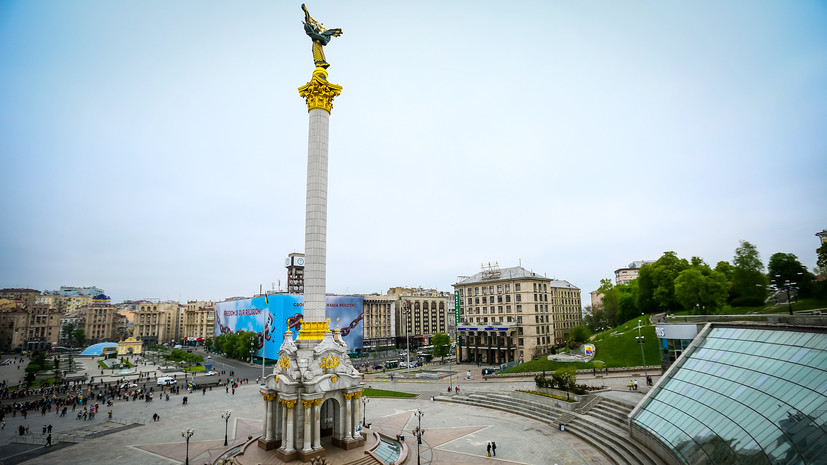 Despite such heavy losses and damage during the second World War, Kyiv was rebuilt relatively quickly and was able to recover economically.
Despite such heavy losses and damage during the second World War, Kyiv was rebuilt relatively quickly and was able to recover economically.
After the collapse of the Soviet Union, Ukraine claimed full independence as a sovereign nation on August 24, 1991, and Kyiv remained the capital city. In the 21st century, Ukraine has continued to face threats on its independence by neighboring Russia.
In 2014, Russia illegally annexed the peninsula of Crimea from Ukraine, which signaled the beginning of the ongoing Russo-Ukrainian war.
Russia initiated a full-scale invasion of Ukraine at the end of February 2022, and has been launching repeated attacks on the city of Kyiv and many others throughout the country.
Features of KyivKyiv and the Dnieper RiverAt the start of 2021, Kyiv had a population of 2.96 million people. This makes it the most populous city in Ukraine and the seventh-most in all of Europe. The city is located in the northern central region of the country, and the Dnieper River runs through it.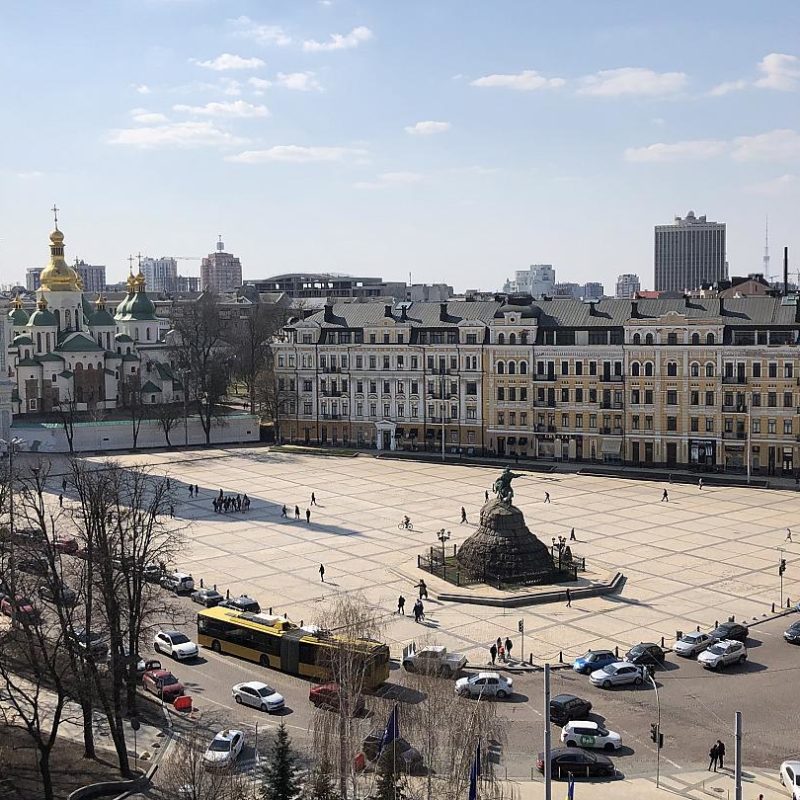
Kyiv has a moderate continental climate, characterized by hot summers and cold winters. The seasons of spring and autumn are short but generally consist of pleasant weather. June, July, and August are the hottest months, with an average daily high of around 25°C. December, January, and February are usually the coldest months, with average daily high temperatures hovering around 0°C.
While these are the averages, it’s not uncommon for temperatures to exceed 30° in Kyiv during the summer, and for them to drop below -6° during the winter.
Languages of KyivThe official language of Ukraine is Ukrainian, and this is spoken alongside Russian as the two most spoken languages in the capital city of Kyiv. There is a history of Ukrainians preferring to speak Russian in the public sphere because it was considered to be more sophisticated, but this is changing.
Since the Russian annexation of Crimea in 2014, there has been a nationalistic push for more Ukrainians to speak the country’s official language instead of Russian.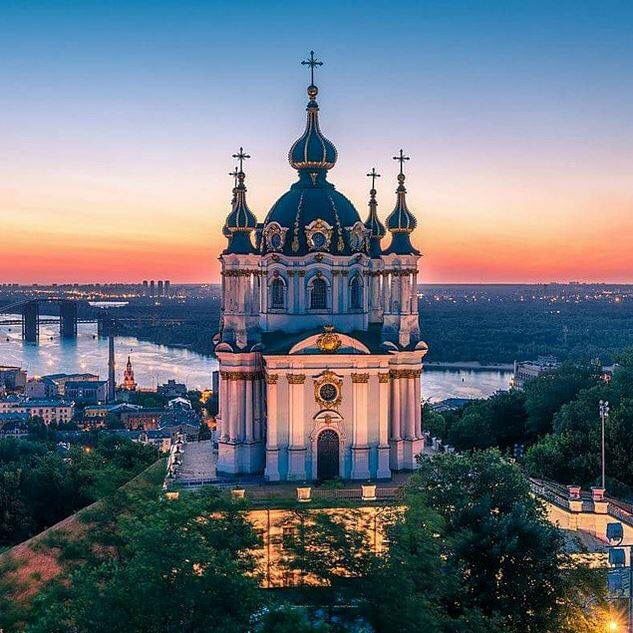 Native speakers of Ukrainian are more likely to also speak Russian than native Russian speakers are to speak Ukrainian. Although these two languages are not mutually intelligible, conversations will sometimes happen in both languages if each speaker can understand each language.
Native speakers of Ukrainian are more likely to also speak Russian than native Russian speakers are to speak Ukrainian. Although these two languages are not mutually intelligible, conversations will sometimes happen in both languages if each speaker can understand each language.
Other languages spoken in Kyiv don’t account for nearly as many speakers, but they are quite diverse. It’s possible to hear residents of the city speaking in Belarusian, Polish, Armenian, and Azerbaijani, among several others. During times of peace, Kyiv also sees tourists and students from many countries around the world.
Religion of KyivThe majority of residents in the Ukrainian capital describe their religion as Orthodox Christianity. This is true even though religion was discouraged by officials while the country was under Soviet rule until 1991. During this period, there were few people who continued to attend church regularly, and the number of publicly declared non-believers grew significantly.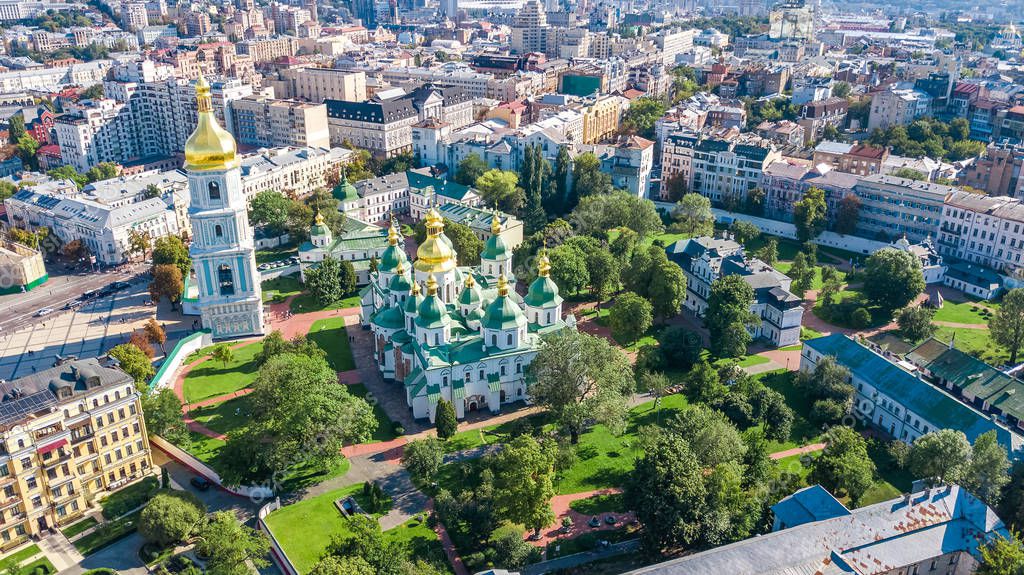 Today there are also populations of Protestants, Jews, and Muslims, although these groups are in the minority within the city.
Today there are also populations of Protestants, Jews, and Muslims, although these groups are in the minority within the city.
For architecture buffs, there’s a lot to enjoy in Kyiv. The city’s buildings are extremely diverse, mainly because of the city’s journey through a wide range of different architectural styles throughout history. A keen eye will be able to spot more than 30 architecture styles, such as Baroque, classical, Soviet, Art Nouveau, and Postmodern, just to name a few.
Mansions, churches, theaters, monuments, and universities are just some impressive examples of architecture to be found in this capital city. It is possible to experience many building styles just by walking around the city center on foot.
Places to Visit in KyivDespite its relatively small size for a capital city, there are a number of famous landmarks and places to see in Kyiv. One advantage of the city’s size is that most of these places are located nearby from each other.
Unfortunately, many of Ukraine’s historical landmarks and places to see are at risk of damage or destruction due to the Russian invasion of the country. Precautions are being taken in Kyiv in an effort to prevent unnecessary destruction.
Maidan NezalezhnostiThis site is often referred to as Independence Square in English, and it is the central square in Kyiv. It is certainly one of the most recognizable places in the capital city, and it features the Independence Monument.
Maidan NezalezhnostiThe square is also renowned for being the site of several political rallies and protests that have taken place since the Ukrainian independence movement began in 1990. It’s a strong symbol of independence in Ukraine and is currently surrounded by barricades of sandbags in the face of Russian military advancement on the city (as of 17 March 2022).
Kyiv-Pechersk LavraCalled the Monastery of the Caves in English, it is an important religious and historical site in the city of Kyiv. It is one of Ukraine’s seven UNESCO World Heritage Sites and has been a significant center for Eastern Orthodox Christianity since its foundation in 1051.
It is one of Ukraine’s seven UNESCO World Heritage Sites and has been a significant center for Eastern Orthodox Christianity since its foundation in 1051.
This monastery complex includes a large underground section of caves that are full of important religious items as well as mummified monks. The complex is still active today, with monks residing.
Saint Sophia CathedralThis is another of the most iconic landmarks in Ukraine’s capital. Its construction began toward the beginning of the 11th century and took around 20 years to complete.
Since its foundation, the cathedral has seen its share of damages due to a Mongol invasion in 1240 and during the 16th century while Polish-Lithuanian Commonwealth attempted to join the Catholic and Orthodox churches.
The church was eventually rebuilt, only to be threatened with destruction during the Soviet anti-religious campaigns of the 1920s. It survived destruction, but it was turned into a historical museum by Soviet authorities in 1934. The cathedral is currently a secular museum of Christianity in Ukraine and is mostly visited by tourists.
The cathedral is currently a secular museum of Christianity in Ukraine and is mostly visited by tourists.
Given its proximity to the Security Service in Ukraine (a potential target for the Russian military), there are fears that the cathedral could once again sustain significant damages due to the 2022 Russian invasion.
National Art Museum of UkraineThis is the oldest museum in Kyiv, dating back to 1899. The pair of lion sculptures at the doors of this building inspire some to refer to it as the “museum of lions.” On the inside, you’ll find almost 40,000 exhibits of important Ukrainian artwork.
Motherland MonumentThe Motherland Monument stands an impressive 62 m / (203 ft) tall and is made of stainless steel. It’s located on top of the Ukrainian State Museum of the Great Patriotic War, on the bank of the Dnieper River that runs through Kyiv.
Motherland Monument
Construction of the statue began in 1979 and was officially opened in 1981. There was some controversy surrounding the statue at around the time of its inception because some people thought the money required to build it could be spent more effectively elsewhere.
There was some controversy surrounding the statue at around the time of its inception because some people thought the money required to build it could be spent more effectively elsewhere.
It has remained a controversial subject until the present day, in part because of the Soviet symbol of a hammer and sickle on the statue’s shield. Soviet and Communist symbols were outlawed by the Ukrainian Parliament in 2015, but this ban does not apply to World War II memorials. This is still under debate in Ukraine.
National Opera and Ballet Theater of UkraineOften considered to be the country’s most beautiful theater, the National Opera of Ukraine was constructed in 1856 and officially established in 1867. It is known for its beautiful facade and for the numerous famous performances that have taken place inside under both Soviet and Ukrainian control.
National Opera and Ballet Theater of UkraineMystetskyi ArsenalLook no further for your fix of culture than the Mystetskyi Arsenal. This massive cultural institution was once a military factory, but it’s been converted into Ukraine’s primary center for the arts. You’ll find modern art installations, music and theater performances, and much more.
This massive cultural institution was once a military factory, but it’s been converted into Ukraine’s primary center for the arts. You’ll find modern art installations, music and theater performances, and much more.
Unfortunately, events have been indefinitely suspended to make efforts to keep people and important pieces of art safe from the Russian invasion. The team at Mystetskyi Arsenal issued a statement on the day Russia declared war on Ukraine.
Saint Andrew’s ChurchThis is another immediately recognizable feature to be found in Kyiv. The blue-and-white exterior and emerald roof on this church look out over the neighborhood of Podil and the Dnieper River from atop a hill.
St. Andrew’s ChurchLike many sites in Ukraine, this church has seen its share of conflict and damages. It’s even been struck by lightning twice. Fortunately, the church is still standing and is currently in good condition, making it a popular place to visit among tourists in Kyiv.
Tourism has steadily grown in the capital city of Ukraine since the country regained independence in 1991, but there continue to be challenges in keeping the industry alive. Tourism began to rise at a faster rate after a visa-free policy was put into place for EU-member states and Switzerland in 2005. The final match of the UEFA Euro 2012 was held in Kyiv, and this was another major attractor of tourists, both foreign and domestic.
Tourism in Ukraine reached a high number of tourists in 2019, with 2.5 million visitors from other countries. As happened in most countries around the world, tourism was greatly reduced after the beginning of the coronavirus pandemic in 2020.
In 2021, tourism in Kyiv and Ukraine was on the rise and expected to continue its upward trend, but this came to an end with the beginning of the Russian invasion of the country in February 2022.
All civilian flights into and out of Ukraine have been suspended, and it is no longer considered a safe destination for tourists.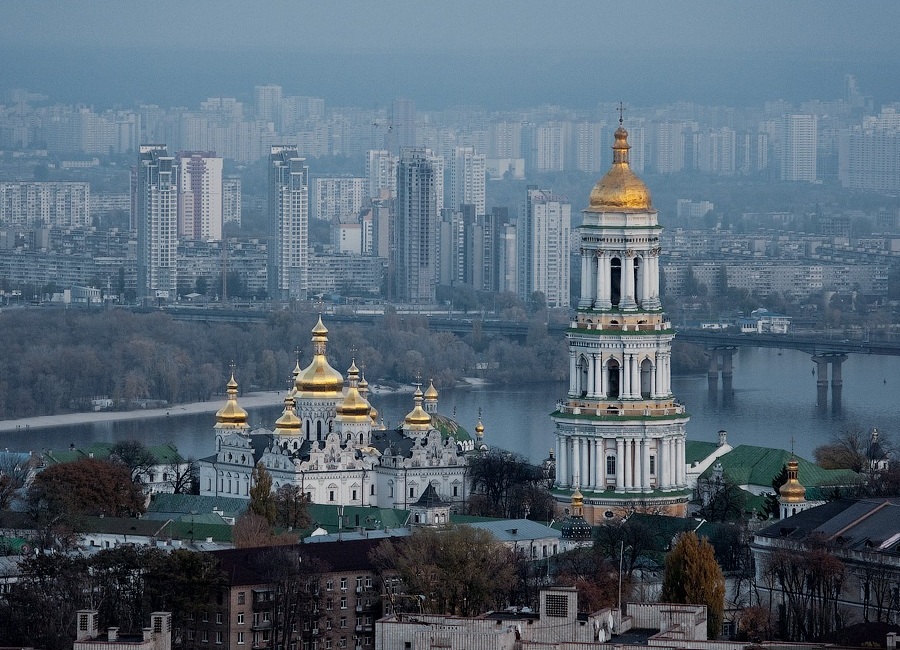
The lack of tourism in the foreseeable future is just one of the many ways Ukraine will continue to face economic difficulties caused by the Russo-Ukrainian war.
Foreigners still in the country can refer to this resource to get up-to-date safety information in Ukraine.
Ukraine-Russia: Where is Kyiv? When Kiev changed to Kyiv, is Kyiv same as Kiev and Kiev or Kyiv pronunciation?
As Russia’s military attack on Ukraine continues, Western leaders are imposing further sanctions amid calls from Ukrainian President Volodymyr Zelenskyy for tougher action.
In the wake of Tuesday’s strike on Kyiv’s TV tower, killing at least five people and damaging a nearby holocaust memorial, President Zelenskyy warned of “history repeating” itself while the world watches on.
A 40 mile long military convoy was spotted approaching the Ukrainian capital on Tuesday (March 1) as cluster munition attacks and alleged use of thermobaric weapons by Russia continue to be seen despite denials from Russian military leaders.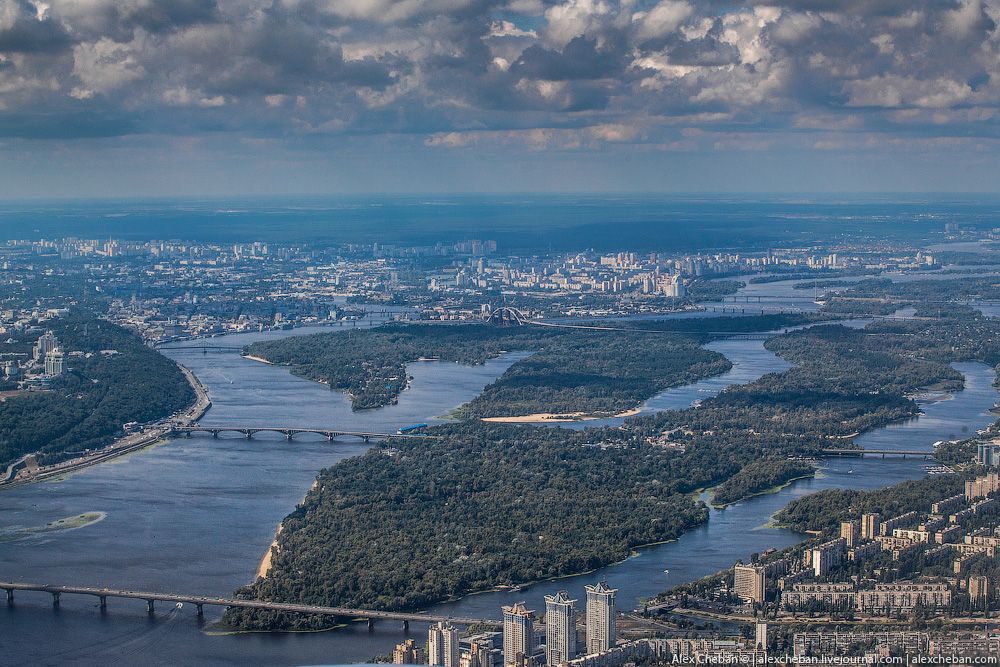
Read More
Read More
What is a cluster bomb? What are vacuum bombs and thermobaric weapons — and has …
Since the full scale invasion began on Thursday February 24, explosions have been seen in Kyiv, as well as in Odessa and Kharkiv.
Here’s what you need to know as Kyiv and its difference to ‘Kiev’ pronunciation and spelling.
Where is Kiev?
Ukraine-Russia: When did Kiev change to Kyiv? Is Kyiv same as Kiev? Kiev or Kyiv pronunciation? Where is Kyiv?Kiev or Kyiv is the capital, the most-populated city in Ukraine and the seventh-most populous city in Europe as well as one of the oldest.
The population, as of January 2021, was 2,962,180.
It is situated in the north-central area of Ukraine on the Dnieper River on the edge of the Polesia woodland area.
Kyiv is surrounded by the Kyiv Oblast (administrative region).
Where is Kiev? Why has Kiev become Kyiv? What is the capital of Ukraine? Kiev or Kyiv pronunciation.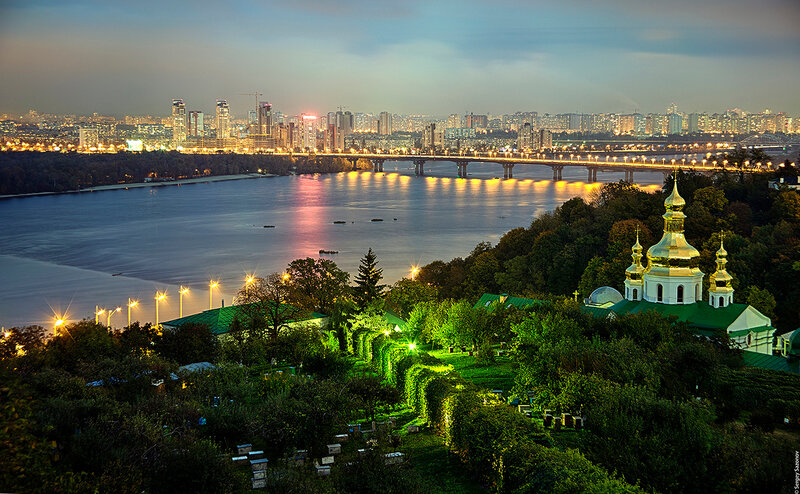 Defence secretary Ben Wallace gives a statement about Russia and Ukraine at a Joint Expeditionary Force ministerial meeting at Belvoir Castle, Leicestershire. Picture date: Tuesday February 22, 2022.
Defence secretary Ben Wallace gives a statement about Russia and Ukraine at a Joint Expeditionary Force ministerial meeting at Belvoir Castle, Leicestershire. Picture date: Tuesday February 22, 2022.The city has grown up on both banks of the Dnieper.
Russia-Ukraine crisis LIVE: Russian paratroopers attack Kharkiv | Nicola Sturgeon promises medical supplies to Ukraine
Why has Kiev become Kyiv?
The city’s Ukrainian name, written in the Ukrainian Cyrillic alphabet, is Ки́їв.
Where is Kiev? Why has Kiev become Kyiv? What is the capital of Ukraine? Kiev or Kyiv pronunciation. Infographic PA Graphics.When written in the Latin alphabet is it regularly referred to it by it’s romanized name Kiev or Kyiv.
The name itself is understood to be a composite word literally meaning ‘Kyi’s Castle’, named for the founder of the city.
In Norse sources, Kyiv has been called Kœnugarðr.
Kiev has been the historic English-language name for the city, but its usage in the West is now dwindling because it is based on a historical Russian derivation of the name.
The growing conflict between Russia and Ukraine has, in part, prompted a shift to the official romanized title Kyiv.
Which countries have the most nuclear weapons and why did Ukraine give up its nuclear arsenal?
When did Kiev change to Kyiv?
After Ukraine’s 1991 independence, regulations were introduced about the national guidance for transliterating place names from Cyrillic to Latin alphabets.
The rules applied to legislative and official acts and documents from Ukrainian officials, and was a clear sign of the spelling intended to be used. The guidance called for Kyiv as the official name.
The spelling has now officially replaced Kiev in all English-speaking foreign diplomatic missions and governments around the world, including across the EU.
In 2018, the #CorrectUA campaign to promote the official spellings of Ukrainian places was launched by the Foreign Ministry in an effort to correct ‘outdated, Soviet-era’ monikers.
Russia-Ukraine: Where is Ukraine? What countries border Ukraine — and why Ukraine isn’t in NATO
How to pronounce Kyiv
The pronunciation of Kyiv is subtly different from the Russia-derived name for the city.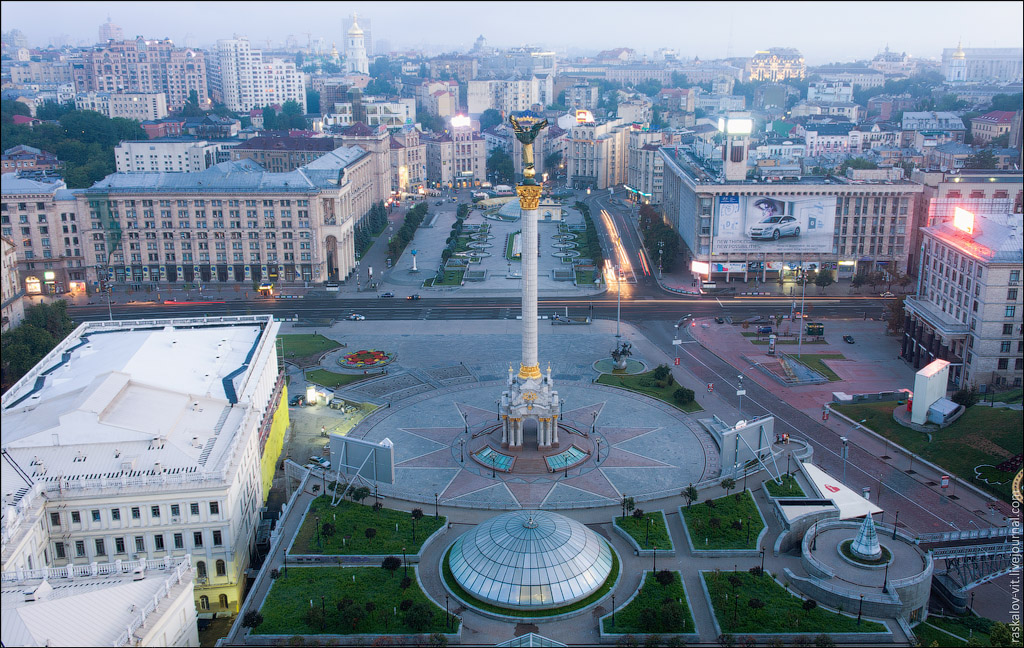
Whereas Kiev was pronounced by English speakers as KEY-EV, the proper way to say the Ukrainian capital’s name is KEE-EVE.
Nina Jankowicz, a fellow at the Wilson Center and former Ukrainian Foreign Ministry comms adviser, has spoken about the importance of correct pronunciation.
«How we describe Ukraine and Ukrainians and their cities is paramount to how the world perceives Ukraine,» says Jankowicz, who wrote an op-ed in the Washington Post in 2019 and tweeted this video too.
«And part of that perception,» she says, «is about you describing Ukraine as its own distinct entity, not as a part of this alleged sphere of influence that Vladimir Putin wants to resurrect, in which all Slavic countries are part of a giant brotherhood and he is the king of them.»
Additional reporting by PA
A message from the Editor:Thank you for reading this article. We’re more reliant on your support than ever as the shift in consumer habits brought about by coronavirus impacts our advertisers.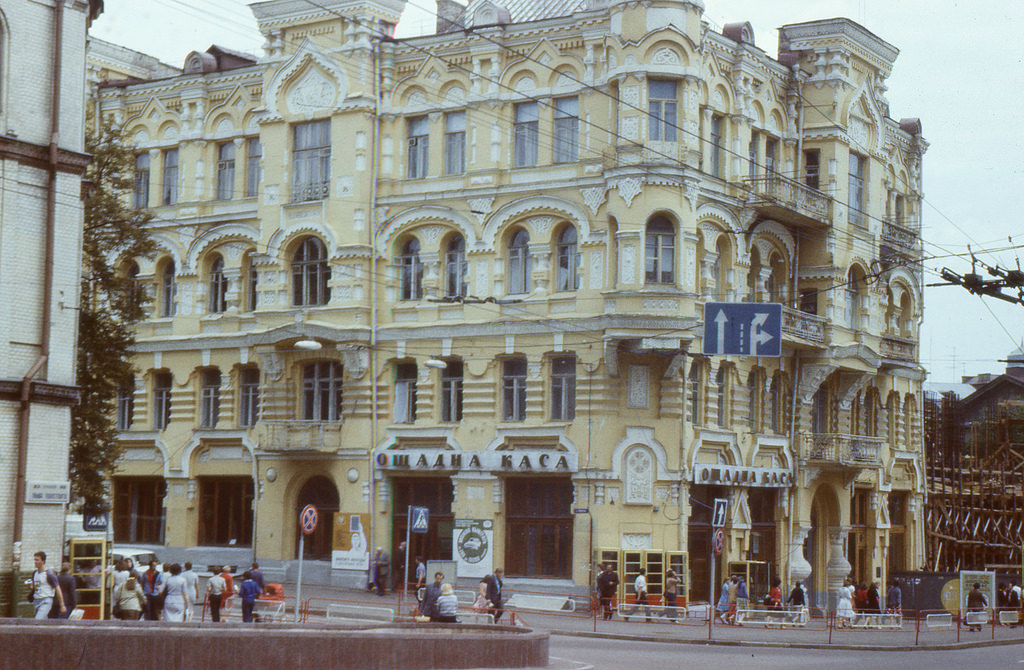 If you haven’t already, please consider supporting our trusted, fact-checked journalism by taking out a digital subscription.
If you haven’t already, please consider supporting our trusted, fact-checked journalism by taking out a digital subscription.Kyiv — New World Encyclopedia
Kyiv (/kiːv/ KEEV), or Kiev (/ˈkiːɛv/ KEE-ev) Ukrainian: Київ, romanized: Kyiv, pronounced [ˈkɪjiu̯], the capital and the largest city of Ukraine, is located in the north central part of the country on the Dnieper River.
Founded in the fifth or sixth century as a trading post, it acquired eminence in the tenth to twelfth centuries a capital of Kievan Rus’, a medieval East Slavic state. Destroyed during the Mongol invasion in 1240, it was a provincial capital of marginal importance until the city prospered during the Russian industrial revolution in the late nineteenth century. From 1934, Kiev was the capital of the Ukrainian Soviet Socialist Republic. During World War II, the city suffered significant damage, but recovered, remaining the third largest city of the Soviet Union, to become, after independence in 1991, the capital of Ukraine.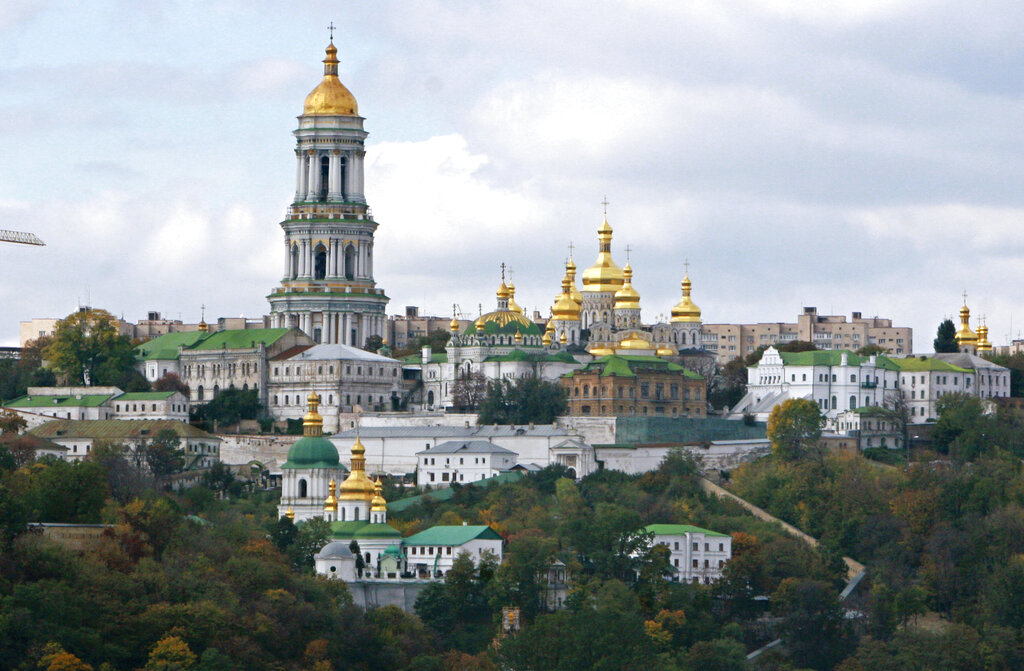
Contents
- 1 Geography
- 2 History
- 2.1 Capital of Rus
- 2.2 Under Lithuania and Poland
- 2.3 Life under the tsars
- 2.4 Revolution
- 2.5 World War II
- 2.6 Post-war growth
- 2.7 Chernobyl nuclear accident
- 2.8 Independence
- 3 Government
- 4 Economy
- 5 Demographics
- 6 Society and culture
- 7 Looking to the future
- 8 Gallery
- 9 Notes
- 10 References
- 11 External links
- 12 Credits
Kiev is an important industrial, scientific, educational and cultural center of Eastern Europe. UNESCO has recognized the «spiritual and intellectual influence of Kiev-Pechersk Lavra which contributed to the spread of Orthodox thought and the Orthodox faith in the Russian world from the seventeenth to the nineteenth century,» and as such designated Kiev’s religious buildings a World Heritage Site in 1990.
Geography
A Landsat 7 image of Kiev and the Dnieper River.
The name Kyiv is translated as belonging to Kyi, who was one of four legendary founders of the city, along with brothers Shchek and Khoryv, and sister Lybid. Kiev is the traditional and most commonly used English spelling of the name, but since the 1995 adoption of Kyiv by the Ukrainian government as a preferred spelling, the Ukrainianized version Kyiv is gaining usage.
The city is located at an elevation of 587.3 feet (179 meters) on both sides of the Dnieper River, which flows south towards the Black Sea. The older right-bank (western) part of the city has numerous woody hills, ravines and small rivers, and is a part of the larger Dnieper Upland adjoining the western bank of the Dnieper. Kiev expanded to the Dnieper’s lowland left bank (to the east) only in the twentieth century. Significant areas of the left-bank Dnieper valley were artificially sand-deposited, and are protected by dams.
The Dnieper River forms a branching system of tributaries, isles, and harbors within the city limits.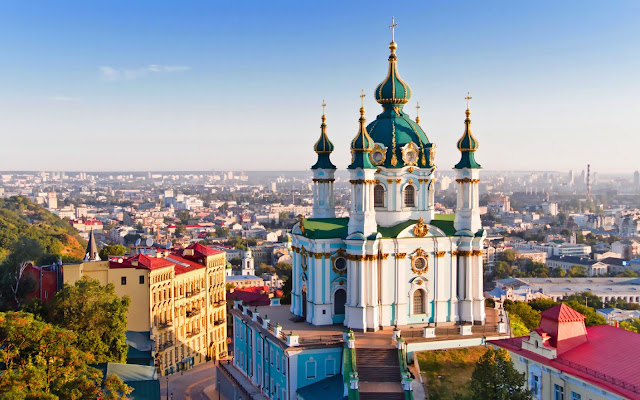 The mouth of the Desna River and the Kiev Reservoir are at the north of the city, and the Kaniv Reservoir at the south. Both the Dnieper and Desna rivers are navigable at Kiev, although limited by the reservoir shipping locks and the winter freeze-over.
The mouth of the Desna River and the Kiev Reservoir are at the north of the city, and the Kaniv Reservoir at the south. Both the Dnieper and Desna rivers are navigable at Kiev, although limited by the reservoir shipping locks and the winter freeze-over.
Kiev has a continental humid climate. The average maximum daytime temperature in January of 24.8°F (-4°C), rising to an average maximum of around 77°F (25°C) in July. Snow cover usually lies from mid-November to the end of March, with the frost-free period lasting 180 days on average, but surpassing 200 days in recent years. Average annual precipitation is 26.6 inches (677mm).
Kiev covers an area of 300 square miles (780 square kilometers).
Most of the Kiev’s historical attractions, as well as most business and governmental institutions, are located on the right bank. In the twentieth century, the city expanded into the eastern left bank, which is predominantly residential. There are large industrial and green areas on both banks.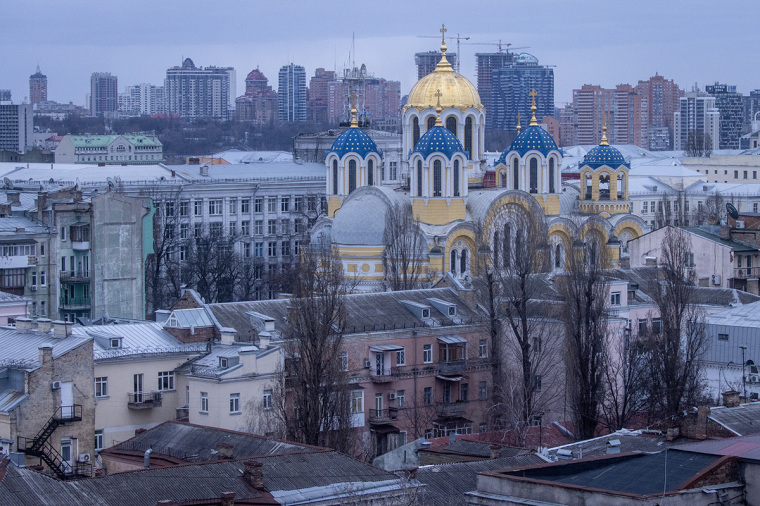
Kiev’s downtown is a dotted contrast of new, modern buildings among the pale yellows, blues and grays of older apartments. The most expensive properties are located in the Pechersk, and Khreshchatyk areas, while it is prestigious to own a property in the newer Kharkivskyi neighborhood or Obolon Raion along the Dnieper. Ukrainian independence brought Western-style residential complexes, modern nightclubs, classy restaurants, and prestigious hotels.
To attract tourists, buildings at the center of Kiev have been restored and redecorated, especially the Khreshchatyk street and Independence Square. Many historic areas of Kiev, such as Andriyivskyy Descent, have become popular street vendor locations, where one can find traditional Ukrainian art, religious items, books, game sets (most commonly chess) as well as jewelry for sale.
History
A fragment of Russiae, Moscoviae et Tartariae map by Anthony Jenkinson (London 1562) published by Ortelius in 1570.
The Podol neighborhood of Kiev. 1890 postcard.
Ruins of Kiev, as seen during World War II.
The first settlements around Kiev date from 15,000 to 40,000 years ago, according to archaeological findings. Around 3000 B.C.E., tribes there practiced agriculture and animal husbandry, and traded with the nomadic steppe dwellers to the south, with Scythians, Sarmatians, and Khazars, and with the ancient Greek colonies on the Black Sea coast.
According to a twelfth century chronicle, each of three East Slav brothers, Kiy, Shchek, and Khoriv, established a settlement upon a hill, which grew to become Kiev. A small stream in the area was named after their sister Lybed. Lacking historical records for the founding dates of the city, it is believed that Kiev was probably founded in the fifth century. (There are no known historical records as to the founding dates of the city. Sources generally provide varying estimates of the fifth or sixth century C. E.) May 1982 was chosen to celebrate the city’s 1500th anniversary.
E.) May 1982 was chosen to celebrate the city’s 1500th anniversary.
Capital of Rus
During the eighth and ninth centuries, Kiev was an outpost of the Khazar empire, and in the late ninth century Kiev was ruled by the Varangian nobility. About 882, the Novgorod ruler Oleg captured Kiev and made it the center of the first East Slavic state, Kievan Rus. The introduction of Christianity in 988 made Kiev the spiritual center of Rus, which thrived from the eleventh to the early twelfth century. It was reputed as one of the largest cities in the world at that time, with a population exceeding 100,000 people. The Cathedral of St. Sophia, parts of the Monastery of the Caves, and the ruins of the Golden Gate remain from the 400 churches built at that time.
Troops of Andrei Bogolyubsky (1111–1174), a prince of Vladimir-Suzdal, sacked Kiev during a war in 1169. In 1240, the Mongol invasion of Rus led by Batu Khan (1205–1255) destroyed Kiev.
Under Lithuania and Poland
In 1321, the greatly diminished city and surrounding area was conquered by Gediminas (1275–1341) for the Grand Duchy of Lithuania.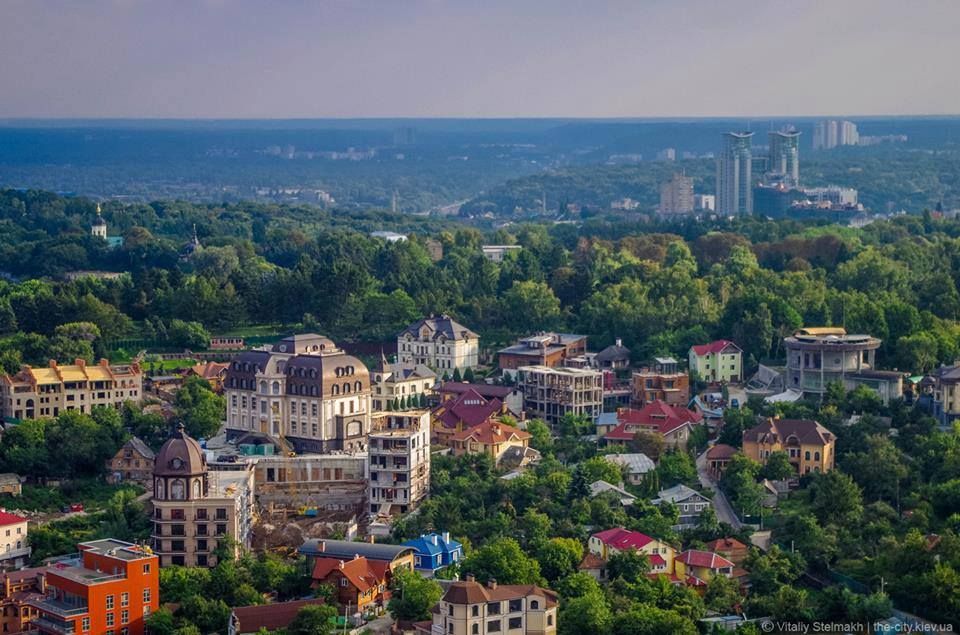
Life under the tsars
Cossack hetman Bohdan Khmelnytsky (1595—1657) and Crimean Tatars entered Kiev in 1648. The 1654 Pereyaslav Agreement submitted Ukraine to Moscow until 1667, when the Treaty of Andrusovo made Kiev and the Dnieper left-bank part of Ukraine an autonomous Cossack state protected by Moscow.
Russian empress Catherine the Great (1729-1796) abolished Ukrainian autonomy in 1775.
Revolution
After the 1917 Russian Revolution, Kiev became the capital of the independent Ukrainian People’s Republic on November 7, 1917. Kiev changed hands 16 times from the end of 1918 to August 1920.[3] The Russian revolutionary Bolsheviks took control of Kiev in 1918 and finally in 1920. After the Ukrainian SSR was formed in 1922, Kharkiv was declared its capital. The Soviet industrialization that began in the late 1920s turned Kiev, a former center of commerce and religion, into an industrial, technological and scientific center.
One of the largest national catastrophes of the Ukrainian nation in modern history with direct loss of human life in the range of millions was the Ukrainian Famine, or Holodomor.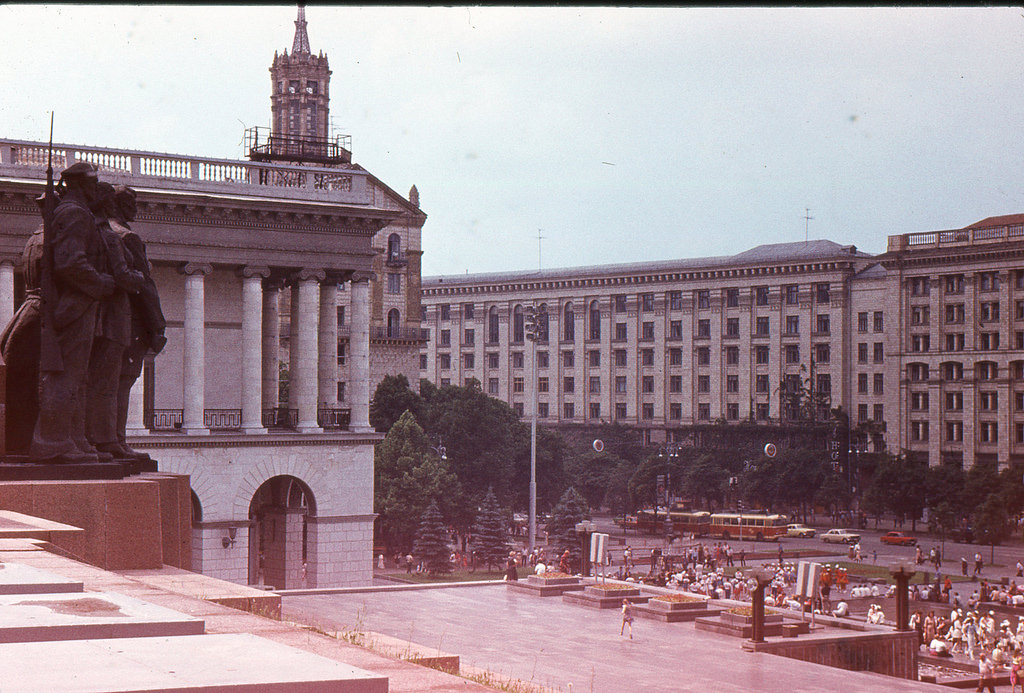 While this was a part of a wider famine that also affected other regions of the USSR, the term Holodomor is specifically applied to the events that took place in territories populated by ethnic Ukrainians. In 1932-1933 over seven million Ukrainians, roughly one quarter of the population, perished in a famine that most modern scholars agree was caused by the policies of the government of the Soviet Union under Joseph Stalin implemented by Lazar Kaganovich, rather than by natural reasons. For this reason, the Holodomor is sometimes referred to as the Ukrainian Genocide, [4] arguing that the Holodomor was engineered by the Soviets, with the intent to force collectivization and destroy any independent national consciousness.
While this was a part of a wider famine that also affected other regions of the USSR, the term Holodomor is specifically applied to the events that took place in territories populated by ethnic Ukrainians. In 1932-1933 over seven million Ukrainians, roughly one quarter of the population, perished in a famine that most modern scholars agree was caused by the policies of the government of the Soviet Union under Joseph Stalin implemented by Lazar Kaganovich, rather than by natural reasons. For this reason, the Holodomor is sometimes referred to as the Ukrainian Genocide, [4] arguing that the Holodomor was engineered by the Soviets, with the intent to force collectivization and destroy any independent national consciousness.
In 1934, the capital of Ukrainian SSR was moved to Kiev, and the city boomed again during the years of the Soviet industrialization. At that time, many old churches, such as St. Michael’s Golden-Domed Cathedral and the Fountain of Samson, were demolished, while others, such as Saint Sophia Cathedral were confiscated. Continued migration changed the ethnic balance of the city from the previous Russian-Ukrainian parity to predominantly Ukrainian, although Russian remained the dominant language.
Continued migration changed the ethnic balance of the city from the previous Russian-Ukrainian parity to predominantly Ukrainian, although Russian remained the dominant language.
In the 1930s, recurring political trials were organized in the city to purge «Ukrainian nationalists,» «Western spies,» and opponents of Soviet leader Joseph Stalin (1878–1953). In the late 1930s, thousands of Kievite intellectuals and party activists were arrested in the night, hurriedly court-martialed, shot and buried in mass graves.
World War II
During World War II (1939-1945), Nazi Germany entered Kiev on September 19, 1941. Before the evacuation of all significant industrial enterprises, the Red Army planted more than 10,000 mines throughout the city, controlled by wireless detonators. On September 24, when the German invaders had settled in, the mines were detonated, destroying major buildings and setting the city ablaze for five days. More than a thousand Germans were killed in what was «the biggest and most sophisticated booby trap in history. «[5]
«[5]
During two days in September 1941, the Nazi Einsatzgruppen massacred at least 33,771 of Kiev’s Jews at the Kiev suburb of Babi Yar, which was also a site of additional mass murders of up to 60,000 captured Soviet citizens over the following years, including Roma, POWs and anyone suspected in aiding the resistance movement).
The Soviet Army liberated the city on November 6, 1943. For its role during the war, the city was later awarded the title Hero City.
Post-war growth
Post-wartime in Kiev was a period of rapid growth. The arms race of the Cold War caused the establishment of a powerful technological complex in the city, specializing in aerospace, microelectronics, and precision optics. Dozens of industrial companies were created employing highly skilled personnel. Dozens of research institutes formed the Academy of Sciences of the Ukrainian SSR. More than a dozen military schools and academies were established here, also specializing in high-tech warfare. A new wave of Russification took place in the 1970s, in which universities and research facilities were gradually and secretly discouraged from using the Ukrainian language.
A new wave of Russification took place in the 1970s, in which universities and research facilities were gradually and secretly discouraged from using the Ukrainian language.
Chernobyl nuclear accident
On April 26, 1986, the fourth reactor of the Chernobyl Nuclear Power Plant, located 100 km north of Kiev, exploded. However, the prevailing winds blew most radioactive debris away, although some areas of Kiev were polluted. Kievans were neither informed about the threat of the accident, nor recognized as its victims. On May 1, 1986, Communist Party leaders ordered Kievans (including hundreds of children) to take part in a parade in the city’s center—»to prevent panic.» Later, thousands of Chernobyl refugees were resettled in Kiev.
Independence
After 57 years as the capital of the Ukrainian Soviet Socialist Republic of the Soviet Union, and in the wake of the 1985-1991 collapse of the Soviet Union, the Ukrainian independence was proclaimed on August 24, 1991. Kiev became the capital.
The city was the site of mass protests over the 2004 Ukrainian presidential election by supporters of opposition candidate Viktor Yushchenko beginning November 22, 2004, at Independence Square. Much smaller counter-protests in favor of Viktor Yanukovych also took place. From November 2013 until February 2014, central Kyiv became the primary location of Euromaidan.
Government
Ukraine is a republic in which the president, who is elected by popular vote for a five-year term, and is eligible for a second term, is the chief of state, and the prime minister is head of government. The unicameral Supreme Council, or Verkhovna Rada, has 450 seats allocated to members on a proportional basis to those parties that gain three percent or more of the national electoral vote. Members serve five-year terms.
The Kiev municipality has a special legal status within Ukraine in that the city is subordinated directly to the national-level branches of the Government of Ukraine, skipping the regional level authorities of the Kiev Oblast.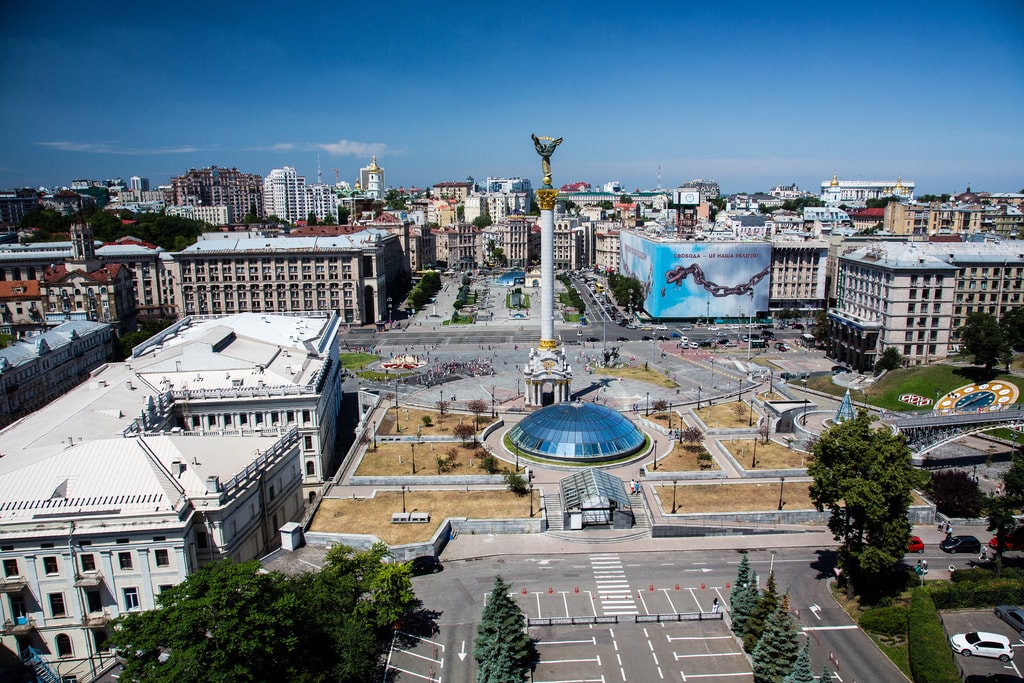 Additionally, the leading governmental position is held by the locally elected, rather than appointed, figure, and the municipal self-governance institutions have increased responsibility in local affairs.
Additionally, the leading governmental position is held by the locally elected, rather than appointed, figure, and the municipal self-governance institutions have increased responsibility in local affairs.
The popularly elected Kiev City Council is the city-level legislative body of Kiev. The Mayor of Kiev, who is independently elected by a separate election, chairs the council and is the head of the City State Administration.
Administratively, the city is divided into 10 «raions» («districts»), which have their own locally elected governments with jurisdiction over a limited scope of affairs. Kiev is further informally divided into neighborhoods, each housing from about 5000 to 100,000 inhabitants.
Economy
The Kiev River Port.
After Russia, the Ukrainian republic was the most important economic component of the former Soviet Union. Its fertile black soil generated more than one-fourth of Soviet agricultural output, and its farms provided substantial quantities of meat, milk, grain, and vegetables to other republics.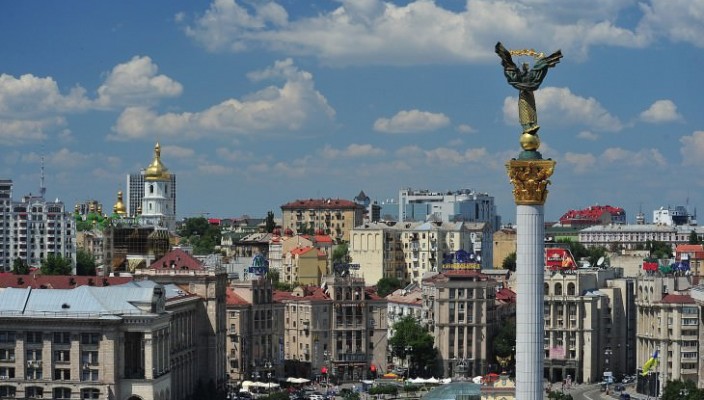 Likewise, its diversified heavy industry supplied unique equipment (including large diameter pipes) and raw materials to industrial and mining sites (vertical drilling apparatus) in other regions of the former USSR.
Likewise, its diversified heavy industry supplied unique equipment (including large diameter pipes) and raw materials to industrial and mining sites (vertical drilling apparatus) in other regions of the former USSR.
Kiev, as the capital of Ukraine, is the location of government offices. Kiev has the headquarters for Antonov Aircraft Manufacturing company. Kiev Arsenal factory, founded in 1764 as a repair and production facility of the Russian army, is one of the oldest and most famous factories in the city.
Other companies produce equipment for chemical works, such as conveyor lines for vulcanized rubber, linoleum, and fertilizer factories, as well as metal-cutting machines. Other engineering products include hydraulic elevators, electrical instruments, armatures, river-and-sea crafts, motorcycles, and cinematography equipment.
Kiev’s chemical industry produces resin products, fertilizers, plastics, and chemical fibers. Lumber milling and the production of bricks and reinforced concrete items are another well developed industry. Consumer manufactured goods include cameras, thermos flasks, knitwear, footwear, a range of foodstuffs, and hand watches. Kiev is also a large publishing center.
Consumer manufactured goods include cameras, thermos flasks, knitwear, footwear, a range of foodstuffs, and hand watches. Kiev is also a large publishing center.
Kiev has a developed railroad infrastructure including a long-distance passenger station, six cargo stations, depots, and repair facilities. Railways and all-weather roads link Kiev to Moscow, Kharkiv—which is Ukraine’s second largest city—to the port of Odessa, to southern and western Ukraine, and to Poland.
The Kiev River Port is located on the right bank of the Dnieper River in Podil, the historic and administrative district of the city. Boryspil Airport serves many international airlines, and the smaller Zhulyany Airport, serves mostly domestic flights and limited flights to nearby countries.
Public transportation in Kiev includes the metro (underground), short-range trains known as elektrichkas, buses, trolleybuses, trams, taxis, and privately owned minibuses, or marshrutkas. The Kiev funicular climbs up the steep right bank of the Dnieper River and transports 10,000 to 15,000 passengers daily.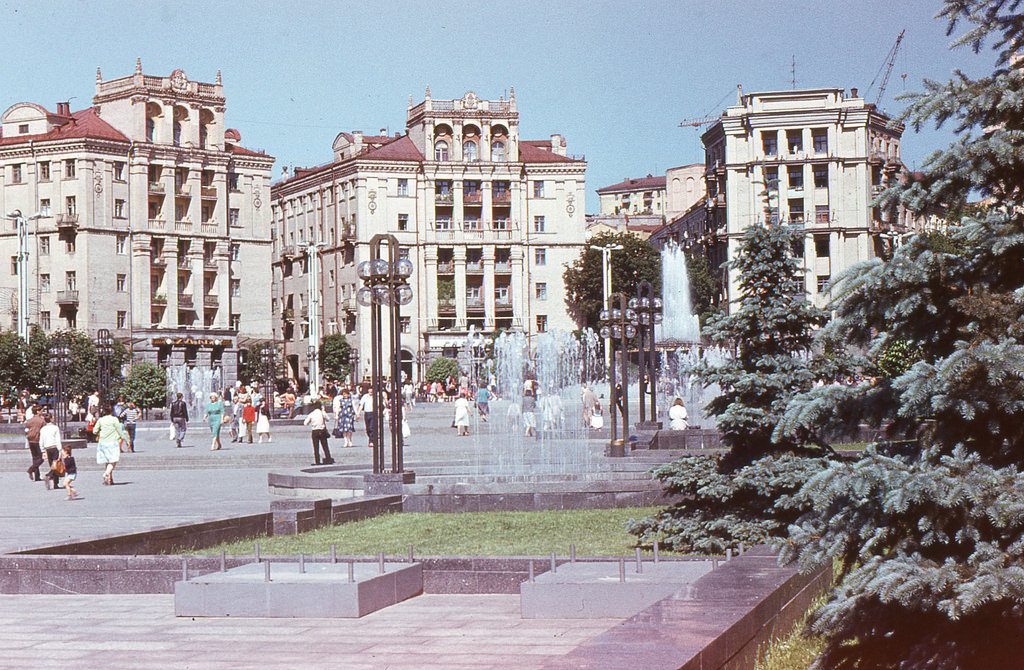
Demographics
The main entrance to the Kyiv Mohyla Academy.
Close to 3 million people live in Kiev. Ukrainians constitute the largest group of the 130 nationalities and ethnic groups residing within Kiev. Russians arecomprise 13.1 percent, Jews 0.7 percent, Belarusians 0.6 percent, Poles 0.3 percent, Armenians 0.2 percent, Azerbaijanis 0.1 percent, Tatars 0.1 percent, Georgians 0.1 percent, and Moldovans 0.1 percent.
Regarding religious affiliation, approximately half of Ukraine’s population adheres to the Kiev Patriarchate of the Ukrainian Orthodox Church. Of the others, a large number belong to the Moscow Patriarchate, while smaller numbers are Ukrainian Greek Catholic, Ukrainian Autocephalous Orthodox, Roman Catholic, Protestant, and Jewish.
Kiev hosts nearly 200 institutions of higher education, notably the Kiev National Taras Shevchenko University, and the Kiev Polytechnic Institute.
Society and culture
Kyiv at night.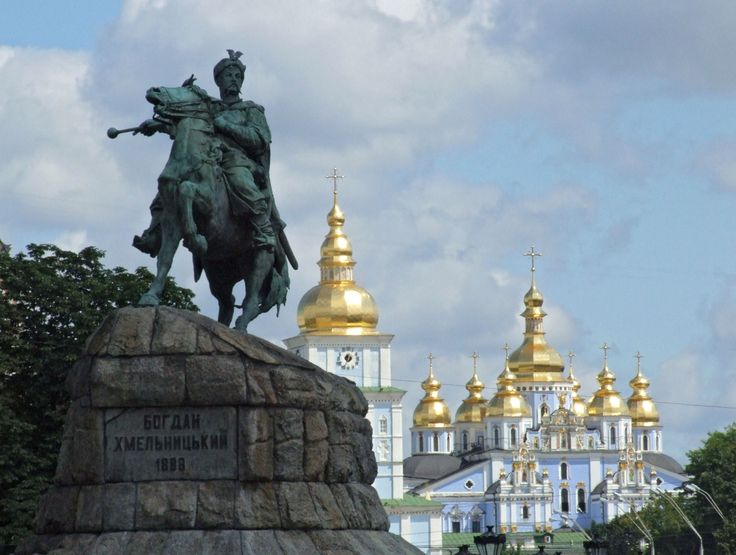
A center of Eastern Orthodox Christianity, Kiev’s holy sites, of which the Monastery of the Caves and the Saint Sophia Cathedral are the most famous, attracted pilgrims for centuries and are recognized as a UNESCO World Heritage Site, and belong to the Seven Wonders of Ukraine collection.
Kiev’s numerous theaters include the Kiev Opera House, Ivan Franko National Academic Drama Theater, Lesya Ukrainka National Academic Theater of Russian Drama, the Kiev Puppet Theater, October Palace, and the National Philharmonic of Ukraine. There are the Dovzhenko Film Studios, and the Kiev Circus. Kiev is known as a green city with two botanical gardens, numerous parks, and trees everywhere.
Museums include the Kiev State Historical Museum, the Museum of the Great Patriotic War, which features the giant Mother Motherland statue, the National Art Museum, the Museum of Western and Oriental Art, and the National Museum of Russian art.
The historic Andriyivskyy Descent is the site of the Castle of Richard Lionheart, the baroque-style St. Andrew’s Church, the home of Kiev-born writer Mikhail Bulgakov, and of the monument to Yaroslav the Wise, the Grand Prince of Kyiv. On Independence Square in the city center, two tall columns elevate monuments of the city protectors—the Archangel Michael, and the goddess-protector Berehynia.
Andrew’s Church, the home of Kiev-born writer Mikhail Bulgakov, and of the monument to Yaroslav the Wise, the Grand Prince of Kyiv. On Independence Square in the city center, two tall columns elevate monuments of the city protectors—the Archangel Michael, and the goddess-protector Berehynia.
Football is the most popular spectator sport in Kiev, followed by basketball and ice hockey. Football clubs include Arsenal Kyiv and Dynamo Kyiv. During the 1980 Summer Olympics held in the Soviet Union, Kiev held the preliminary matches and the quarter-finals of the football tournament at its Olympic Stadium, which is the largest Ukrainian stadium and can accommodate 83,053 spectators.
Looking to the future
Kiev’s long history, its status as the center of the Ukrainian Orthodox Church, and as a World Heritage Site, plus its importance as an industrial, scientific, and educational center, mean the city is well placed to benefit from Ukraine’s economic growth. Although the nation achieved independence in 1991, democracy remained elusive as continuing state control and endemic corruption stalled efforts at economic reform, privatization, and civil liberties. Although the economy was predicted to expand, the government’s plans to reinstate tax, trade, and customs privileges, and to maintain restrictive grain export quotas endanger long-term growth.
Although the economy was predicted to expand, the government’s plans to reinstate tax, trade, and customs privileges, and to maintain restrictive grain export quotas endanger long-term growth.
Gallery
St. Michael’s Golden-Domed Cathedral, 1998 reconstruction.
Holy Dormition Cathedral of the Kiev Pechersk Lavra, post-1991 reconstruction.
St. Andrew’s Church.
St. Sophia Cathedral.
St. Volodymyr’s Cathedral.
Church of Bohoroditsa Pirogoscha in the Podil raion, 1998 reconstruction
Monument to Princess Olga
Golden Gate (Zoloti Vorota), 1982 reconstruction.
National Opera of Ukraine.
National Bank of Ukraine.
«House With Chimaeras»
Notes
- ↑ Major Agglomerations of the World CityPopulation. Retrieved March 17, 2022.
- ↑ Kiev Population 2022 World Population Review.
 Retrieved March 17, 2022.
Retrieved March 17, 2022. - ↑ Modris Eksteins, Walking Since Daybreak: A Story of Eastern Europe, World War II, and the Heart of our Century (Boston: Houghton Mifflin Co., 2000, ISBN 061808231X), 87.
- ↑ Valentina Kuryliw, Holodomor in Ukraine, The Genocidal Famine 1932-33: Teaching Materials for Teachers and Students HREC Education. Retrieved March 17, 2022.
- ↑ Robert E. Conot, Justice at Nuremberg (New York: Harper & Row, 1983, ISBN 9780060151171), 225.
References
ISBN links support NWE through referral fees
- Ascher, Abraham. Russia: A Short History. Oxford: Oneworld, 2002. ISBN 9781851682423
- Burgess, Tom. Kiev. Cityspots. Peterborough: Thomas Cook, 2008. ISBN 9781841579061
- Conot, Robert E. Justice at Nuremberg. New York: Harper & Row, 1983. ISBN 9780060151171
- Eksteins, Modris. Walking Since Daybreak: A Story of Eastern Europe, World War II, and the Heart of our Century.
 Boston: Houghton Mifflin Co., 2000. ISBN 061808231X
Boston: Houghton Mifflin Co., 2000. ISBN 061808231X - Magocsi, Paul R. A History of Ukraine. Seattle: University of Washington Press, 1996. ISBN 0295975806
- Paxton, John. Encyclopedia of Russian History: From the Christianization of Kiev to the Break-up of the U.S.S.R. Santa Barbara, CA: ABC-CLIO, 1993. ISBN 9780874366907
External links
All links retrieved October 5, 2022.
- Kiev or Kyiv: language an issue in Ukraine The Christian Science Monitor.
- Ukraine CIA World Factbook.
- [https://kyivindependent.com/ The Kyiv Independent.
- [https://kse.ua/ Kyiv School of Economics.
- U.S. Embassy in Ukraine.
Credits
New World Encyclopedia writers and editors rewrote and completed the Wikipedia article
in accordance with New World Encyclopedia standards. This article abides by terms of the Creative Commons CC-by-sa 3.0 License (CC-by-sa), which may be used and disseminated with proper attribution.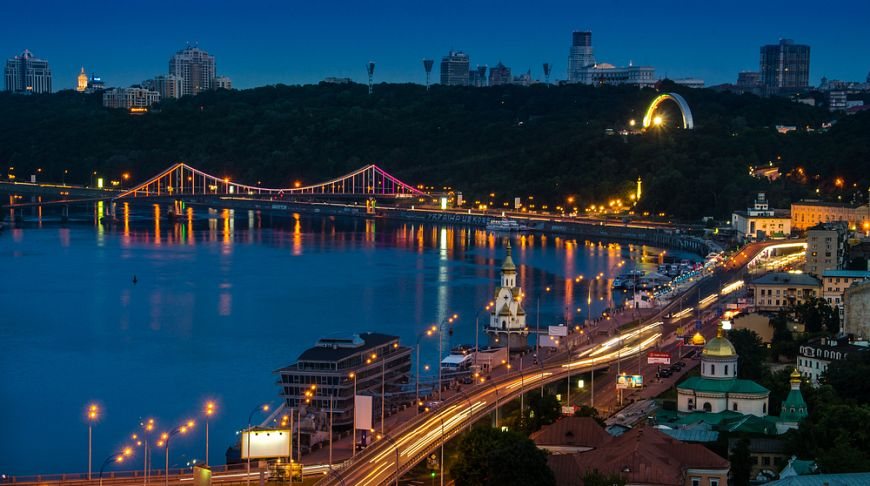 Credit is due under the terms of this license that can reference both the New World Encyclopedia contributors and the selfless volunteer contributors of the Wikimedia Foundation. To cite this article click here for a list of acceptable citing formats.The history of earlier contributions by wikipedians is accessible to researchers here:
Credit is due under the terms of this license that can reference both the New World Encyclopedia contributors and the selfless volunteer contributors of the Wikimedia Foundation. To cite this article click here for a list of acceptable citing formats.The history of earlier contributions by wikipedians is accessible to researchers here:
- Kiev history
- Legal_status_and_local_government_of_Kiev history
- History_of_Kiev history
The history of this article since it was imported to New World Encyclopedia:
- History of «Kyiv»
Note: Some restrictions may apply to use of individual images which are separately licensed.
Киев столица Украины | Самые важные факты о Киеве (Киев)
Киев (Киев) факты
ул. Дегтяревская, 33А,
7 этаж,
03057, г. Киев, Украина.
Киев (Киев) — один из красивейших и один из старейших городов Восточной Европы, сыгравший ключевую роль в развитии восточнославянской цивилизации, а также современной украинской нации. Основан 1500 лет назад, Киев — столица Украины и Киевской области.
Основан 1500 лет назад, Киев — столица Украины и Киевской области.
Название Киев , как говорят, происходит от имени Кия (также Кия), одного из четырех легендарных основателей города (братья Кий, Щек, Хорив и сестра Лыбедь). Легенда широко признана источником киевской мифологии и, соответственно, городского именования. Киев был основан во второй половине V или начале VI века, и в 1982 году официально отмечалось его 1500-летие.
Киев или Киев?
В настоящее время Киев является традиционным и наиболее часто используемым английским названием города, но в 1995 году правительство Украины приняло Киев в качестве обязательной латинизации для использования в законодательных и официальных актах.
Совет по географическим названиям США — это федеральный орган, подчиняющийся министру внутренних дел США. У него есть мандат на стандартизацию географических названий для официальных дел правительства США.
В октябре 2006 года правление утвердило написание Киев как один из официальных типовых бланков столицы Украины.
Киев расположен на живописном берегу Днепра. Это один из самых красивых городов Европы. Половину территории Киева занимают парки и сады. Один из крупнейших городов Европы, Киев с населением 3,14 млн и занимает площадь более 840 квадратных километров.
Самые известные историко-архитектурные комплексы Киева – Софийский собор, где короновались киевские князья в годы величия Киева, и Киево-Печерская Лавра (Печерский монастырь), на территории которой расположены два собора XI в. , в дополнение к своим всемирно известным катакомбам, которые признаны ЮНЕСКО объектом Всемирного наследия.
Также представляют интерес руины Золотых ворот XI века, которые когда-то были главным входом в город. В Киеве находится несколько университетов, в первую очередь Киевский университет (основан в 1834 г.). Украинская академия наук и ее Центральная библиотека, крупнейшая библиотека Украины, расположены в Киеве.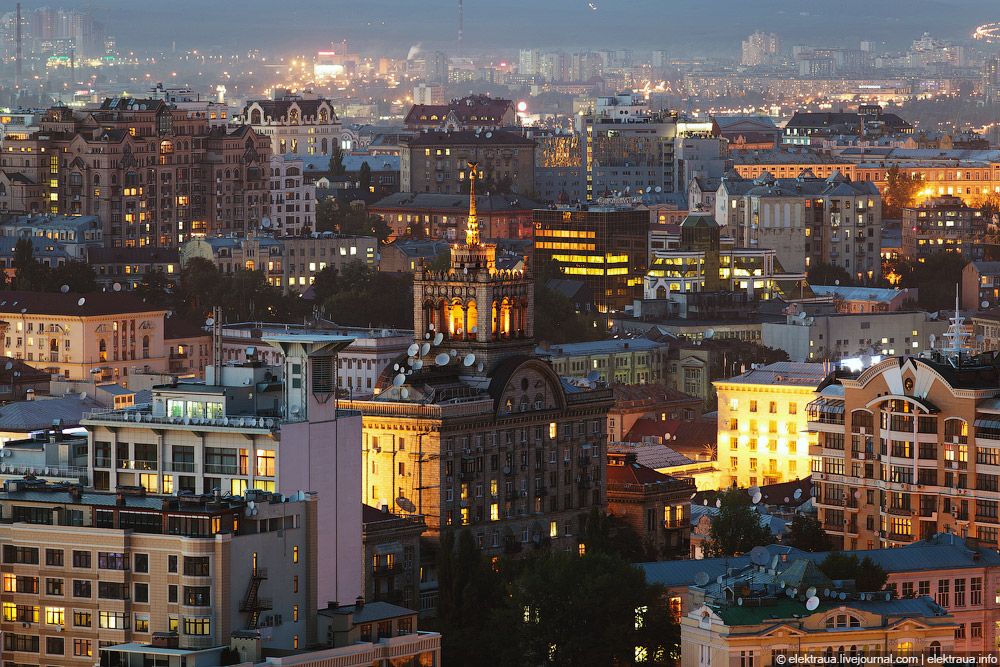 Киев — современный город со множеством памятников архитектуры, более 100 музеев (в том числе Национальный музей истории Украины (1899 г.), Национальный музей естественной истории, Национальный художественный музей Украины, Пирогово), 33 театра (в том числе Музыкальный консерватория, Национальная опера Украины), зоопарк и большой спортивный стадион.
Киев — современный город со множеством памятников архитектуры, более 100 музеев (в том числе Национальный музей истории Украины (1899 г.), Национальный музей естественной истории, Национальный художественный музей Украины, Пирогово), 33 театра (в том числе Музыкальный консерватория, Национальная опера Украины), зоопарк и большой спортивный стадион.
Будучи крупнейшим городом Украины, Киев (Киев) является ведущим промышленным и торговым центром страны. Основные отрасли промышленности Киева включают: пищевую промышленность (особенно переработку свекловичного сахара), металлургию, производство машин, станков, подвижного состава, химикатов, строительных материалов и текстиля. Развитие экономики Украины дало импульс деловой активности города. В настоящее время в городе появляется множество новых офисных центров, банков, торгово-выставочных центров и других коммерческих предприятий.
Киев известен как самый зеленый город . Площадь зеленой зоны составляет 43,6 тыс. га (что составляет 168 кв. м на одного жителя), более половины которой занимают леса, скверы, два ботанических сада, парки и обсаженные деревьями бульвары. На Конференции ООН по изменению климата 2009 года Киев стал единственным городом СНГ, вошедшим в ТОП-30 европейских индексов зеленых городов.
га (что составляет 168 кв. м на одного жителя), более половины которой занимают леса, скверы, два ботанических сада, парки и обсаженные деревьями бульвары. На Конференции ООН по изменению климата 2009 года Киев стал единственным городом СНГ, вошедшим в ТОП-30 европейских индексов зеленых городов.
Киев обслуживается хорошей транспортной сетью. Магистральные железные дороги и всепогодные дороги связывают Киев с Москвой, Харьковом и Донбассом, югом и западом Украины, Польшей. В самом Киеве есть эффективное метро, железнодорожное и автобусное сообщение. Река Днепр судоходна около девяти месяцев в году, а киевский аэропорт «Борисполь» выполняет рейсы в другие города Украины, а также в города Европы, Азии и Северной Америки.
TOP 10 Интересные факты о Киеве
- Археологические раскопки свидетельствуют о первых поселениях на территории Киева 15-20 тысяч лет назад.

- Киев — первая в истории столица Киевской Руси, первого Русского государства (конец IX века — 1240 год). Он был построен на землях Полянского племенного союза, но позднее в него вошли все восточнославянские племена.
- В 988 году князь Владимир ввел христианство в Киевскую Русь. С Киева началось русское христианство и православная культура.
- Киев известен россиянам как «мать городов русских».
- Киев был крупнейшим городом Европы XI века, в пятьдесят раз больше Лондона , в десять раз больше Парижа . Пика своего расцвета он достиг при правлении Ярослава Мудрого (1010-1054 гг. н.э.), имевшего родственные связи с королевскими домами Франции, Норвегии, Венгрии и Польши.
- В конце 15 века в Киеве было Магдебургское право.
- В административном отношении город разделен на «районы» («районы»), которые имеют свои собственные избираемые на местном уровне правительства с ограниченной юрисдикцией.
 В настоящее время насчитывается 10 районов.
В настоящее время насчитывается 10 районов. - Неофициальный логотип Киева — каштановый. Май — самый красивый месяц в Киеве, когда цветут каштаны.
- Киев сыграет ведущую роль в проведении чемпионата Европы по футболу 2012 года.
- Стандартное время в Киеве на 2 часа позже, чем GMT/UTC (летнее время: EEST (UTC+3).
Более интересную информацию и факты об Украине вы можете найти на следующих страницах:
- Украина: Обзор
Экономика Украины
Украинский народ и культура
Украинская земля и климат
История Украины
Юнитс Консалтинг ООО, Бухгалтерские и расчетные услуги в Киеве (Киев)
Киев | Достопримечательности, карта, факты и история
Сводка
Прочтите краткий обзор этой темы
Киев , также пишется Киев , Киев или русский Киев , главный город и столица Украины.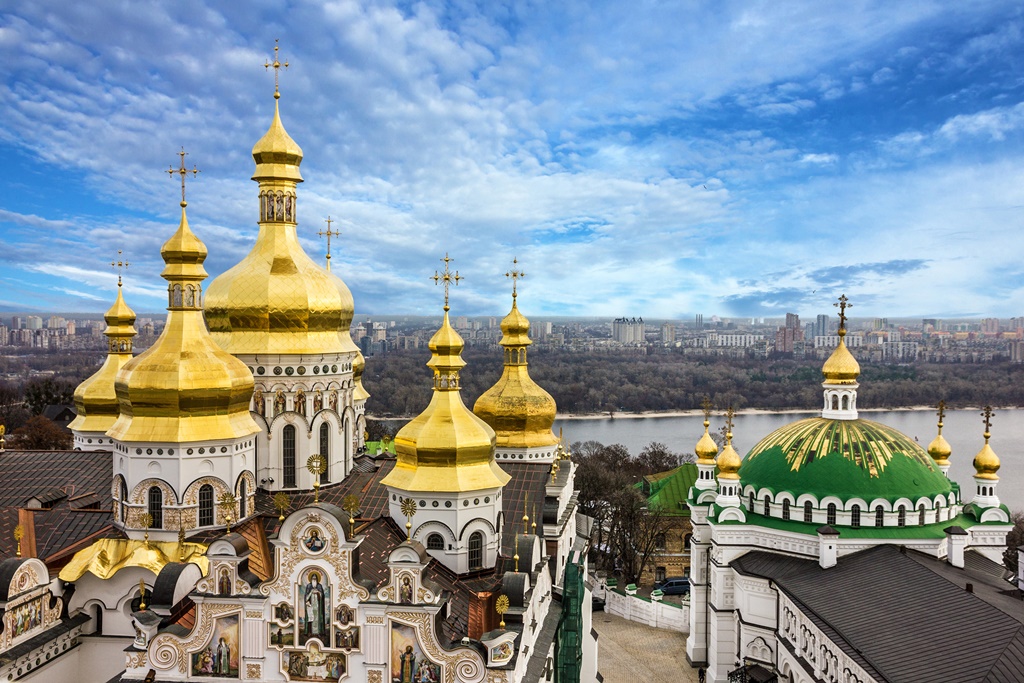 Порт на реке Днепр (Днепр) и крупный железнодорожный узел, это город с древней и гордой историей. Будучи центром Киевской (Киевской) Руси, первого восточнославянского государства, 1000 лет назад она получила титул «Мать городов Руси». Он сильно пострадал во время Великой Отечественной войны, но к середине 19В 50-е годы он был отреставрирован, а во второй половине 20 века в нем шла бурная хозяйственная и культурная жизнь. Независимость Украины от Советского Союза в 1991 году возобновила статус Киева как крупной европейской столицы. Поп. (2001) 2 611 327; (оценка 2021 г.) 2 962 180 человек.
Порт на реке Днепр (Днепр) и крупный железнодорожный узел, это город с древней и гордой историей. Будучи центром Киевской (Киевской) Руси, первого восточнославянского государства, 1000 лет назад она получила титул «Мать городов Руси». Он сильно пострадал во время Великой Отечественной войны, но к середине 19В 50-е годы он был отреставрирован, а во второй половине 20 века в нем шла бурная хозяйственная и культурная жизнь. Независимость Украины от Советского Союза в 1991 году возобновила статус Киева как крупной европейской столицы. Поп. (2001) 2 611 327; (оценка 2021 г.) 2 962 180 человек.
Ландшафт
Городской участок
Город стоит на реке Днепр чуть ниже ее впадения в Десну и в 591 миле (951 км) от ее устья в Черном море. Первоначальное местонахождение находилось на высоком и крутом правом (западном) берегу, который возвышается над рекой внушительной линией обрывов, заканчивающихся холмом Батыева, на высоте 330 футов (100 метров) над средним уровнем реки. Этот обрывистый и лесистый берег, увенчанный золотыми куполами и шпилями церквей и колоколен, а также высотными жилыми домами, делает город привлекательным и впечатляющим зрелищем со стороны Днепра.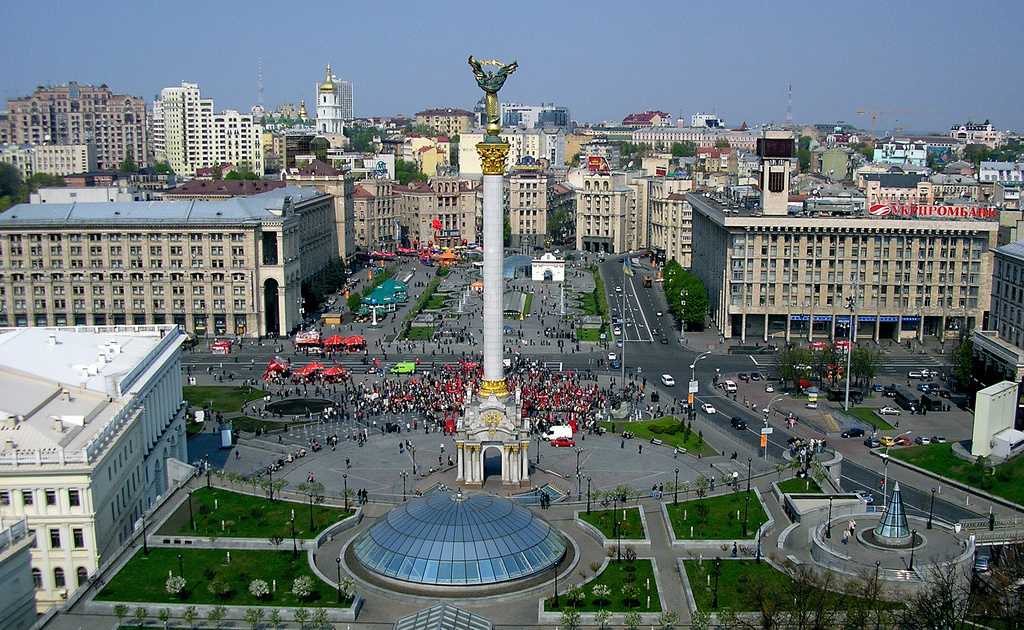 После Второй мировой войны Киев растянулся на широкую, низкую и плоскую пойму левого (восточного) берега.
После Второй мировой войны Киев растянулся на широкую, низкую и плоскую пойму левого (восточного) берега.
Климат
Климат в Киеве умеренно континентальный. Средняя температура января составляет 21 ° F (-6 ° C), а зимние дни с температурами выше нуля не редкость. В холодные периоды с северным или северо-восточным воздушным потоком температура может резко упасть, и был зарегистрирован абсолютный минимум -27 ° F (-33 ° C). Снежный покров лежит обычно с середины ноября до конца марта; безморозный период длится в среднем 180 дней, но в отдельные годы превышает 200 дней. Лето теплое, средняя температура июля составляет 68 ° F (20 ° C), а зарегистрированный максимум — 102 ° F (39 ° C).°С). Среднее годовое количество осадков составляет 25 дюймов (635 мм), с максимальным количеством осадков в июне и июле.
План города
Граница города охватывает территорию площадью 300 квадратных миль (780 квадратных километров) по обоим берегам Днепра. Он разделен на ряд административных районов.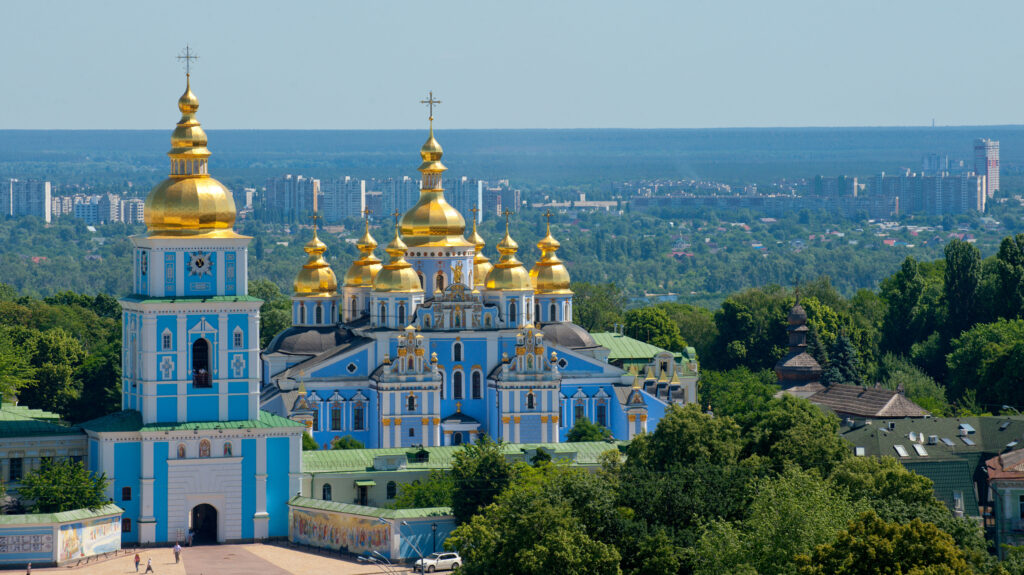 Центром Киева является район древнего Верхнего города, венчающий высокие обрывы Днепра. Хотя в основном это послевоенная застройка, этот центральный район сохраняет свою старую структуру улиц, и здесь находится большинство сохранившихся исторических и архитектурных памятников. Первым среди них является Софийский собор, ныне музей. Он был построен в XI веке и остается, несмотря на некоторые перестройки в стиле барокко в XVIII веке, одним из лучших и красивейших образцов раннерусско-византийского церковного зодчества. Он имеет неф и четыре прохода и увенчан пятью куполами. Интерьер великолепно украшен фресками и мозаикой; в нем находится могила Ярослава I, великого киевского князя, во время правления которого был построен собор.
Центром Киева является район древнего Верхнего города, венчающий высокие обрывы Днепра. Хотя в основном это послевоенная застройка, этот центральный район сохраняет свою старую структуру улиц, и здесь находится большинство сохранившихся исторических и архитектурных памятников. Первым среди них является Софийский собор, ныне музей. Он был построен в XI веке и остается, несмотря на некоторые перестройки в стиле барокко в XVIII веке, одним из лучших и красивейших образцов раннерусско-византийского церковного зодчества. Он имеет неф и четыре прохода и увенчан пятью куполами. Интерьер великолепно украшен фресками и мозаикой; в нем находится могила Ярослава I, великого киевского князя, во время правления которого был построен собор.
Викторина «Британника»
Викторина «Столицы Европы»
Насколько хорошо вы знаете свои европейские столицы? Эта викторина покажет вам название страны на европейском континенте, и вам нужно будет определить ее столицу.
Рядом находится костел св.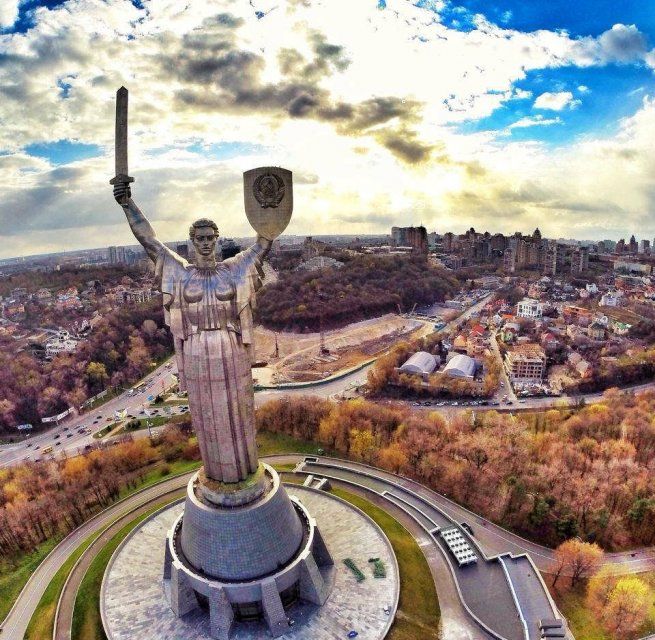 Андрея в стиле барокко, спроектированный Бартоломео Растрелли и построенный в середине 18 века; его расположение на гребне крутого склона к реке делает его яркой достопримечательностью. Другие исторические реликвии в центральной части включают руины Золотых ворот, также построенных в 11 веке в царствование Ярослава; Заборовские ворота, построенные в 1746–48; и остатки Десятинной церкви, или Десятинной церкви, построенной в 9 в.89–996 великим князем Владимиром (Владимиром I).
Андрея в стиле барокко, спроектированный Бартоломео Растрелли и построенный в середине 18 века; его расположение на гребне крутого склона к реке делает его яркой достопримечательностью. Другие исторические реликвии в центральной части включают руины Золотых ворот, также построенных в 11 веке в царствование Ярослава; Заборовские ворота, построенные в 1746–48; и остатки Десятинной церкви, или Десятинной церкви, построенной в 9 в.89–996 великим князем Владимиром (Владимиром I).
На территории бывшего Старого города и в непосредственной близости от него находятся многие городские музеи, театры и общественные здания, а также главные магазины. Осью центра является улица, известная как Крещатик, которая проходит по дну небольшой долины, стороны которой частично засажены террасными садами, перемежающимися высокими современными офисными и жилыми домами. Зелень садов, деревья вдоль улицы, площади, которые она пересекает, — все это в сочетании с пестрыми цветами кирпича, красного и серого гранита и декоративной керамической плитки придает Крещатику привлекательный и красочный вид, которым так восхищаются киевляне.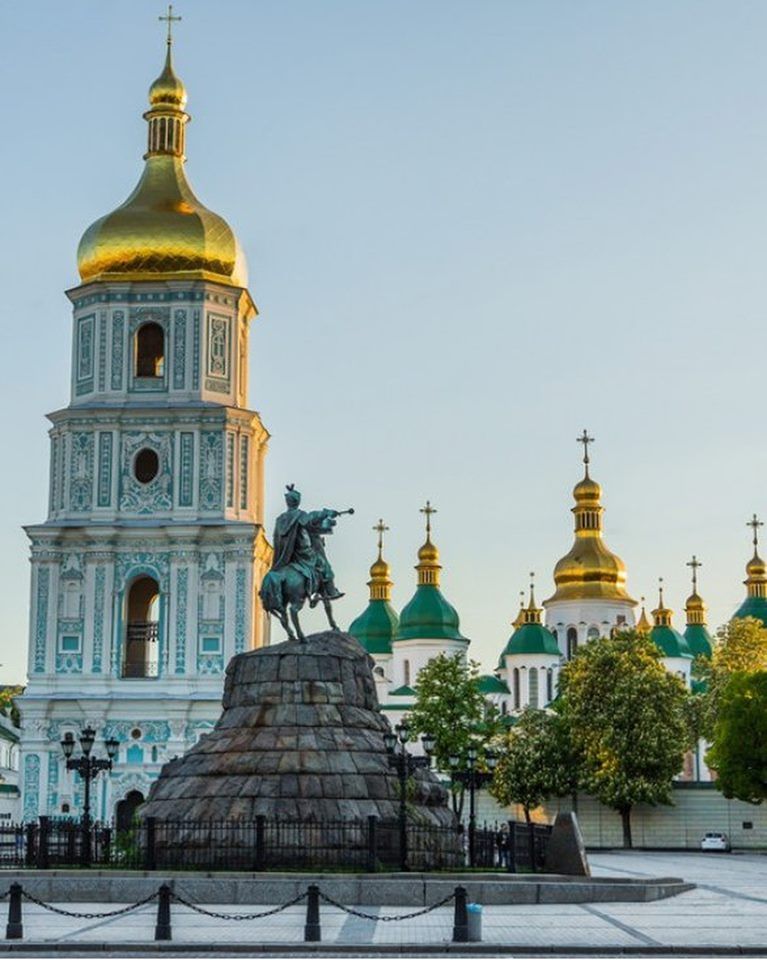 Пожалуй, самая известная общественная площадь на Крещатике — это Майдан Независимости («Площадь Независимости»). Он служил центром протестного движения Майдана (также называемого Евромайданом), которое привело к президенту Украины. Свержение Виктора Януковича в феврале 2014 года. Среди важных зданий на улице — здание горсовета, где проходят заседания избранных депутатов.
Пожалуй, самая известная общественная площадь на Крещатике — это Майдан Независимости («Площадь Независимости»). Он служил центром протестного движения Майдана (также называемого Евромайданом), которое привело к президенту Украины. Свержение Виктора Януковича в феврале 2014 года. Среди важных зданий на улице — здание горсовета, где проходят заседания избранных депутатов.
Оформите подписку Britannica Premium и получите доступ к эксклюзивному контенту. Подписаться сейчас
Крещатик пересекает под прямым углом широкий обсаженный тополями бульвар Тараса Шевченко, на котором стоит университет с броскими красноватыми стенами. Там же находится собор Святого Владимира (до сих пор используется как церковь), построенный в 1862–1896 годах в византийском стиле и украшенный впечатляющими картинами Виктора Васнецова, Михаила Врубеля и других художников. Среди многочисленных статуй в центре Киева выделяются те, что увековечивают память казачьего вождя Богдана Хмельницкого и украинского поэта Тараса Шевченко.
К северу от старого центра находится бывший торгово-еврейский квартал Подола с прямоугольным рисунком улиц и старой купеческой торговой биржей, Домом Договоров, построенный в 1817 году. Также к северу от старого центра расположен речной порт . Южнее центра находится Печерский район, по верхнему берегу реки. В этом районе находятся многие из основных зданий украинского правительства, в том числе дворец со стеклянным куполом, построенный в 1936–39 годах, в котором находится Верховный Совет, и 10-этажный корпус, в котором находится Кабинет министров. Неподалеку находится привлекательный Мариинский дворец, построенный в 1747–1755 годах для Царица Елизавета, реконструированная в 1870 году и ныне используемая для правительственных приемов.
В южной части этого района находится Киево-Печерская Лавра (Печерский монастырь), основанная в середине 11 века, один из самых известных и важных монастырей в истории региона. Именно в лавре монах Нестор помог составить самую раннюю из сохранившихся летописей восточнославянского государства Руси. Успенский собор (внутри стен монастыря), взорванный в 1941 при обстоятельствах, которые остаются невыясненными, был полностью перестроен. Сохранилась Троицкая церковь того же периода. Также внутри стен находится церковь Всех Святых 17-го века и впечатляющая колокольня 18-го века, возвышающаяся на 315 футов (96 метров). Главной особенностью монастыря является система катакомб под ним, в которых захоронены мумифицированные тела ранних монахов и святых, в том числе Нестора. Несмотря на то, что это музей, открытый для публики, Киево-Печерская Лавра до сих пор используется как монастырь. к югу от лавра – еще один монастырь, Выдубицкий, датируемый XI веком; он тоже сильно пострадал во время Второй мировой войны, но позже был отреставрирован.
Успенский собор (внутри стен монастыря), взорванный в 1941 при обстоятельствах, которые остаются невыясненными, был полностью перестроен. Сохранилась Троицкая церковь того же периода. Также внутри стен находится церковь Всех Святых 17-го века и впечатляющая колокольня 18-го века, возвышающаяся на 315 футов (96 метров). Главной особенностью монастыря является система катакомб под ним, в которых захоронены мумифицированные тела ранних монахов и святых, в том числе Нестора. Несмотря на то, что это музей, открытый для публики, Киево-Печерская Лавра до сих пор используется как монастырь. к югу от лавра – еще один монастырь, Выдубицкий, датируемый XI веком; он тоже сильно пострадал во время Второй мировой войны, но позже был отреставрирован.
Вдоль крутого берега реки, выходящей на Верхний город и Печерский район, разбит живописный ландшафтный парк с видом на Днепр. С открывающимися видами парк является одной из самых ярких черт города. В нем есть театр под открытым небом, спортивный стадион и ресторан, а также фуникулер, поднимающийся на 300 футов (90-метровый) уклон.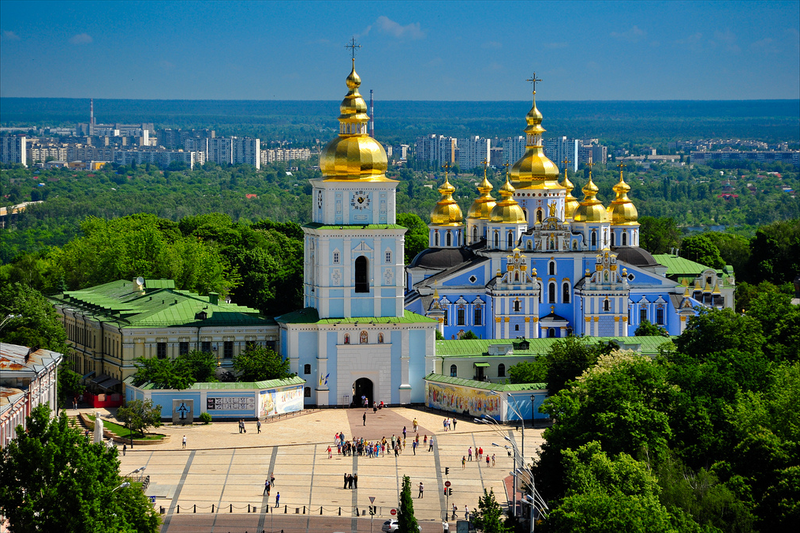 Также в парке много мемориалов. В северной части возвышается статуя великого князя Владимира, принесшего христианство на Русь. Статуя отмечает место, где в 988 году массово крестились киевляне. В южной части, называемой Парком Славы, есть 85-футовый (26-метровый) гранитный обелиск, возвышающийся над могилой Неизвестного солдата, и мемориальный сад. Также в парке находится могила генерала Николая Ватутина, командующего советскими войсками, освободившими Киев в 1943, и ротонда, обозначающая предполагаемую могилу раннего вождя варягов Аскольда.
Также в парке много мемориалов. В северной части возвышается статуя великого князя Владимира, принесшего христианство на Русь. Статуя отмечает место, где в 988 году массово крестились киевляне. В южной части, называемой Парком Славы, есть 85-футовый (26-метровый) гранитный обелиск, возвышающийся над могилой Неизвестного солдата, и мемориальный сад. Также в парке находится могила генерала Николая Ватутина, командующего советскими войсками, освободившими Киев в 1943, и ротонда, обозначающая предполагаемую могилу раннего вождя варягов Аскольда.
Вокруг этих центральных районов Киева тянутся обширные пригороды заводов и жилых кварталов. Поскольку в период правления Иосифа Сталина жилью уделялось мало внимания, большая часть этих пригородов была построена после смерти советского лидера в 1953 году. Микрорайоны состоят из групп многоквартирных домов, в которых проживает от 2500 до 5000 человек. , а также основные услуги, местные магазины, медицинский центр, кинотеатр и начальная школа.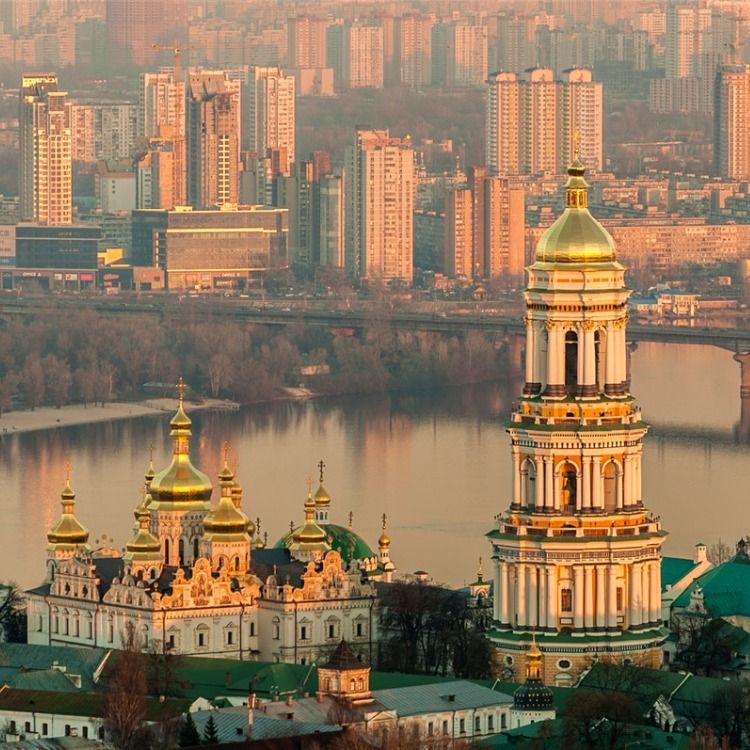 С конца 19В 60-х годах многоквартирные дома обычно были от 12 до 20 этажей и из сборных конструкций. В большинстве квартир всего две или три комнаты, поэтому плотность населения высока как в новых жилых комплексах, так и в старых центральных районах. Растущее количество частных автомобилей создает проблемы с предоставлением гаражей в этих новых районах. Особенностью развития со времен Великой Отечественной войны стало быстрое распространение города по низменному левому (восточному) берегу Днепра, ранее почти не заселенному. Левый берег связан с основной частью Киева железнодорожным мостом и внушительной Е. Автодорожный мост О. Патона, 4,9 м.20 футов (1500 метров) в длину и назван в честь своего создателя.
С конца 19В 60-х годах многоквартирные дома обычно были от 12 до 20 этажей и из сборных конструкций. В большинстве квартир всего две или три комнаты, поэтому плотность населения высока как в новых жилых комплексах, так и в старых центральных районах. Растущее количество частных автомобилей создает проблемы с предоставлением гаражей в этих новых районах. Особенностью развития со времен Великой Отечественной войны стало быстрое распространение города по низменному левому (восточному) берегу Днепра, ранее почти не заселенному. Левый берег связан с основной частью Киева железнодорожным мостом и внушительной Е. Автодорожный мост О. Патона, 4,9 м.20 футов (1500 метров) в длину и назван в честь своего создателя.
Между микрорайонами находятся значительные площади парков и зеленых насаждений. К ним относятся крупные ботанические сады Национальной академии наук Украины и более мелкие университетские ботанические сады (основаны в середине 19 века). На окраине города есть несколько участков леса, которые широко используются для отдыха. На юге находится Голосеевский парк, в котором преобладают лиственные деревья, а на севере — почти 10 000 акров (4450 га) Пуща-Водицкого лесопарка, в основном покрытого хвойными породами. Сочетание ряда факторов делает Киев привлекательным городским центром: это место с его резко контрастирующим рельефом и широким видом на Днепр, обилие зелени в городе и вокруг него, а также множество зданий, представляющих исторический интерес и красоту.
На юге находится Голосеевский парк, в котором преобладают лиственные деревья, а на севере — почти 10 000 акров (4450 га) Пуща-Водицкого лесопарка, в основном покрытого хвойными породами. Сочетание ряда факторов делает Киев привлекательным городским центром: это место с его резко контрастирующим рельефом и широким видом на Днепр, обилие зелени в городе и вокруг него, а также множество зданий, представляющих исторический интерес и красоту.
Как произносится Киев, столица Украины? : NPR
Как произносится Киев, столица Украины? Как правильно называть иностранный город — по его английскому названию, если оно есть, или по его названию на местном языке? Для вовлеченных людей это может быть серьезным делом, связанным с геополитикой.
Мир
Снег покрывает центр Киева в декабре. Ефрем Лукацкий/AP скрыть заголовок
Ефрем Лукацкий/AP скрыть заголовок
переключить заголовок
Ефрем Лукацкий/AP
Снег в центре Киева в декабре.
Ефрем Лукацкий/AP
Как американские журналисты правильно называют иностранный город — по его английскому названию, если оно есть, например, Рим, Дамаск или Мехико, или по его названию на местном языке?
Это вопрос, над которым постоянно бьются американские новостные организации, и то, как они отвечают, часто основано на истории и пожеланиях местного населения, а также на корнях англизированного названия.
На этой неделе NPR решило официально адаптировать эфирное произношение слова «Киев», столица, ранее называвшаяся «Киев», чтобы оно звучало ближе к тому, как оно произносится на украинском языке.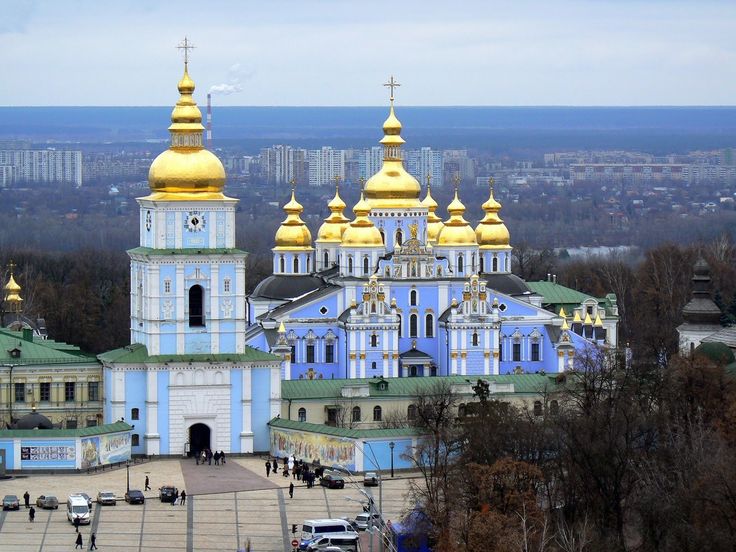 NPR уже изменило написание на Киев в 2019 году.
NPR уже изменило написание на Киев в 2019 году.
Все учтено Соведущая Мэри Луиза Келли, направлявшаяся в понедельник в Киев, чтобы сообщить об угрозе российского вторжения, написала в Твиттере об обоих решениях.
«Для тех, кто спрашивает, @npr использует украинское написание и произношение (не русское) везде, где это возможно, когда пишет об Украине. Киев, а не Киев. КЕЕ-ев, а не КЕЕ-ев.»
Для тех, кто спрашивает, @npr использует украинское написание и произношение (не русское) везде, где это возможно, когда пишет об Украине.
Киев не Киев. КЕЕ-ев, а не КЕЕ-ев.
Подсказка: @michelekelemen @wexler_m #Kyiv #Ukraine
— Мэри Луиза Келли (@NPRKelly) 24 января 2022 г.
«Киев» происходит от русского, и Украина проводит кампанию за украинское написание и произношение с 1990-х годов, после распада Советского Союза. После того, как в 2014 году президент России Владимир Путин приказал войскам вторгнуться в Крым и другие части восточной Украины, многие западные новостные агентства начали подчиняться.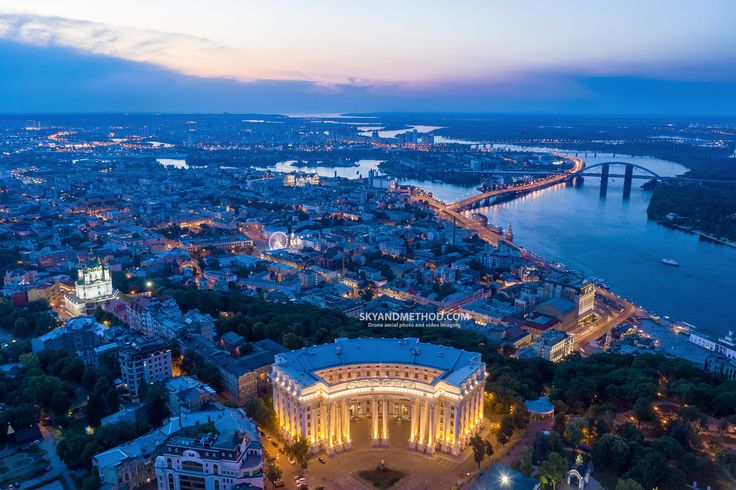
Еще до принятого на этой неделе решения о произношении некоторые ведущие и репортеры NPR уже сами по себе говорили «Киев», вызывая в сети дискуссию о том, следует ли произносить все города на родном языке, и вспоминая 2019 год.слушания в Конгрессе, на которых некоторые законодатели использовали еще одно произношение названия города, превратив его в один слог.
«Теперь, когда все говорят «Кив», далеко ли позади «Пари»?» — спросил ведущий Marketplace Кай Риссдал в понедельник в Твиттере, сославшись на французское произношение слова «Париж».
Теперь, когда все говорят «Кив», далеко ли позади «Пари»?
— Кай Риссдал (@kairyssdal) 21 января 2022 г.
Произношение связано с геополитикой и идентичностью
Несмотря на то, что дебаты о номенклатуре легко приуменьшить, для вовлеченных в них людей часто возникает серьезный вопрос, связанный с идентичностью, геополитикой и национальной безопасностью.
Нина Янкович, научный сотрудник Центра Вильсона и бывший советник по связям с общественностью МИД Украины, вспоминает, что много лет назад определенный артикль в «Украине» был опущен, потому что эта формулировка связана с русским национализмом.
Объяснение, как произносится столица Украины, для всех, кто сегодня запутался 🇺🇦 pic.twitter.com/f9Geu0h5gN
— Нина Янкович 🇺🇦🇺🇸 (@wiczipedia) 13 ноября 2019 г.
«То, как мы описываем Украину, украинцев и их города, имеет первостепенное значение для того, как мир воспринимает Украину», — говорит Янкович, написавшая статью в Washington Post в 2019 году о дебатах по произношению, а также снял видео.
«Часть этого восприятия, — говорит она, — заключается в том, что вы описываете Украину как самостоятельную единицу, а не как часть этой предполагаемой сферы влияния, которую Владимир Путин хочет возродить, частью которой являются все славянские страны. гигантское братство, и он их король».
Споры о подражании просторечию в английском языке более интенсивны, чем в других языках, из-за его текущего статуса глобального языка.
Мир
Байден консультируется с европейскими союзниками по поводу сдерживания российского вторжения в Украину
Виталий Чернецкий, украинец по происхождению, профессор кафедры славянских и евразийских языков и литератур Канзасского университета, говорит, что большинство украинцев не возражают, что в польском языке есть свои названия городов в соседних странах, включая Киев, которым правила Польша.

 Retrieved March 17, 2022.
Retrieved March 17, 2022. Boston: Houghton Mifflin Co., 2000. ISBN 061808231X
Boston: Houghton Mifflin Co., 2000. ISBN 061808231X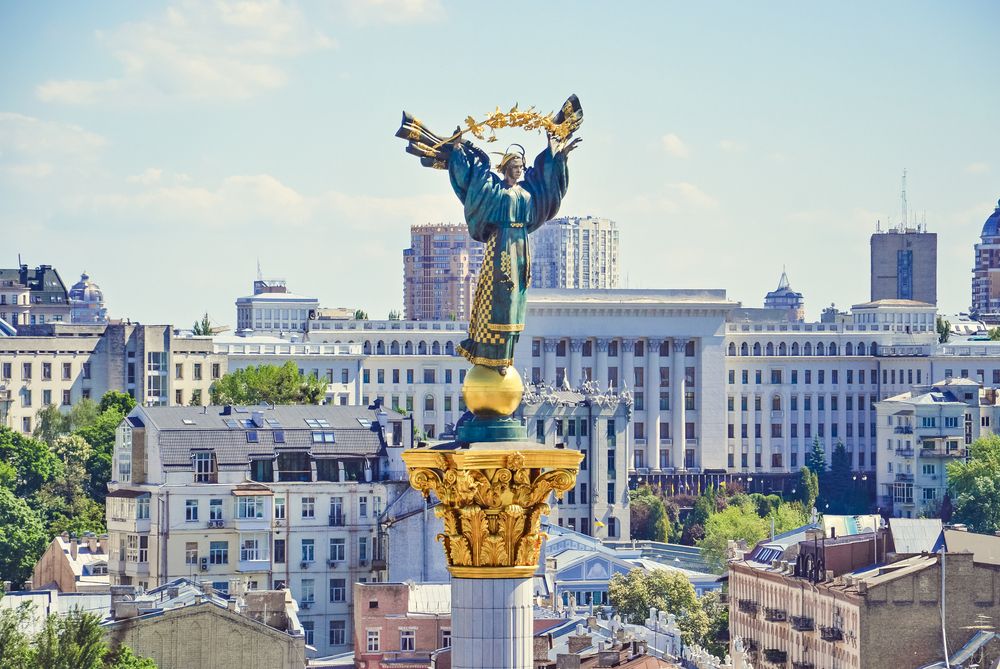
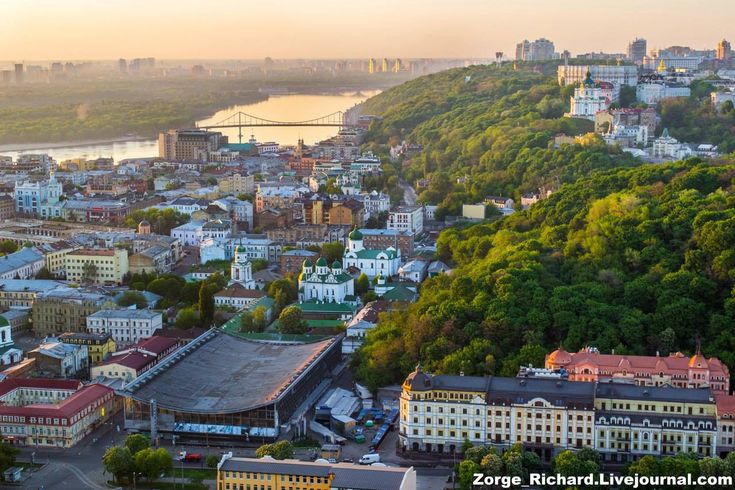 В настоящее время насчитывается 10 районов.
В настоящее время насчитывается 10 районов.